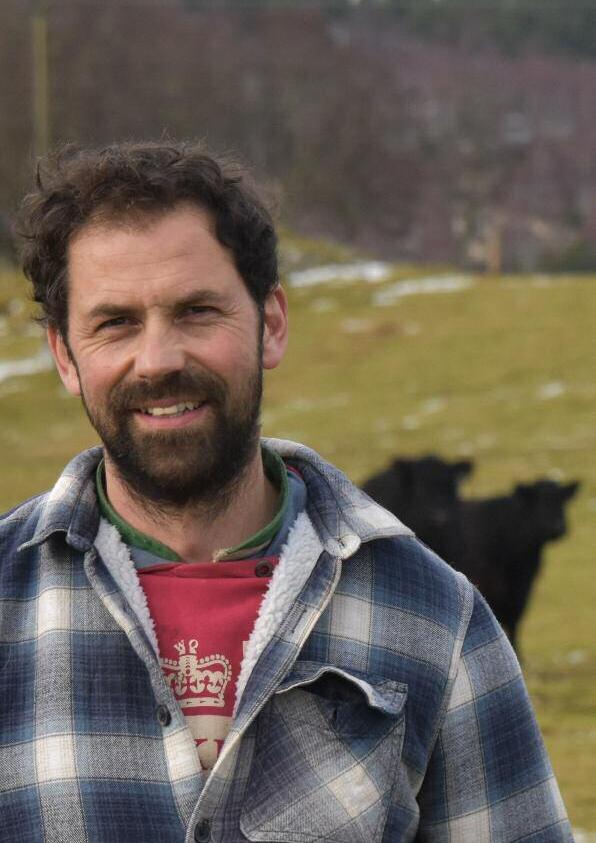
farmingscotland.com
/ May 2024 • Issue 151
in a
April
Farming
National Park World Sheep Shearing Lofoten Islands, Norway World Shearing Record Bid Mutch Wins Spanish Open Latest Machinery and much more... Celebrating 20 Years of Publication

en ts Book Reviews 55 Lofoten Islands, Norway 56 WORLD TRAVELS/ INTEREST MACHINERY New With Krone 42 Are You Covered? 43 Latest Machinery – NH & MF 44 Latest Machinery – Siloking, ROC, Slurrykat 46 Latest Machinery – JCB, McHale, Faersin, Case 48 Latest Machinery – Joskin, Pottinger, Merlo 49 Two New Claas Combines Hit the Market 50 More Transmission for CaseIH Tractors 52 Are Ewe OK? 21 Electrical Weeding Management 23 Keep People Safe from Asbestos 22 RHASS Celebrates 240 Years 25 Success for Controlled Release Fertiliser 53 BUSINESS ARABLE Importance of Old Farm Buildings for Bats 24 BUILDINGS Boosting Lamb Survival 20 Ireland’s Remote Working Hubs 22 Movers & Shakers 38 EDUCATION /MONITOR FARMS SHEEP / SHEARING 52 Una Goes for Nine Hour World Record 26 British Wool Update 30 New Zealand Shears – Powered by Wool 32 Welsh Rare-Bit 34 Lister – Supporting Golden Shears for 50 Years 35 Gavin Mutch Wins Spanish Open 36 New Ambassadors for British Wool 37
Jalex Livestock 4 Farming in Cairngorm National Park 12 Top Chef Cooks up Interest in Red Meat 22
Cont
BEEF



56
It’s lambing time and with the wettest March on record and apparently also the wettest 18 months on record it has been a trying time for farmers across the board
We built a shed sheep last year as predator numbers – foxes, badgers and ravens and the odd black-backed gull –were extreme and many lambs were being attacked before they had a chance.
This year the shed has proved its worth
Roving reporters Chris McCullough and Petra Jacob have stories from Northern Ireland and the Lofoten Islands in Norway respectively Both are interesting reads
The Scottish Government is committed to designating at least one new park by 2026, to join Cairngorms National Park and Loch Lomond and the Trossachs National Park
The Scottish Borders, Galloway,

Lochaber, Loch Awe and Tay Forest – are in the running to be Scotland's next National Park
Farmers and crofters on the Isle of Skye stood strong against the Island becoming a National Park “There will be an extra layer of bureaucrecy, the infrasturcture on the island is poor and we are over run with tourists as it is,” commented John Angus McCusbic who farms at Totarder, Struan, before Skye was ruled out of the equation These reasons are echoed by John MacPherson of Balliemeanoch, Portsonachan, Loch Awe for the proposed Argyllshire Park
John Angus set up a ‘Skye National Park No More!’ Facebook page
Lochaber have done likewise and a petition – PE2089: Stop More National Parks in Scotland – had 2035 signatures
I interviewed Bobby MacKenzie and his sister June, who farm 22 968acres in the Cairngorm National Park
farmingscotland.com
MacPherson Editor Eilidh MacPherson Editor/publisher farmingscotland com Magazine Marbrack Farm Carsphairn Castle Douglas DG7 3TE
60644 0797 7897867 www farmingscotland com farmingscotland com on facebook Photos by Eilidh MacPherson unless otherwise stated on page 21
Eilidh
016444
51
JALE X live sto
by Chris McCul

o ck lough

 by Chris McCullough
by Chris McCullough
JALEX LIVESTOCK
BEEF and sheep farmers throughout the UK, Ireland and further afield, will have no doubt heard of Jalex Livestock run by James Alexander in Northern Ireland Well-known for multiple success stories in livestock show rings around the country, James has also built up his thriving business sourcing and rearing breeding cattle and sheep to sell to other farmers.
Most of the livestock are now sold via auctions held on the Alexander farm near Randalstown in County Antrim, where the family have also run a tractor and 4x4 sales business since the 1970s James farms in partnership with his parents Nelson and Anne, wife Ruth and their young family on their 1000 acre farm
There are around 750 to 900 heifers on the farm at any one time and a sheep flock consisting of 200 North Country Cheviot ewes and over 100 pedigree Suffolk sheep
James said: “We currently farm 1000 acres, mostly owned with some conacre (in Ireland the letting by a tenant of small portions of land prepared for crops or grazing) and run 750 to 900 heifers at any one time The business plan is to source suitable heifers from the UK and Ireland, get them in calf and sell them.”
His livestock sourcing business was born in 2014 when the Alexander beef farm underwent major restructuring James sold off the farm’s herd of 450 suckler cows and steered the business into the new direction of supplying in-calf beef heifers and breeding sheep to other farmers
This means buying in top quality beef heifers to get in calf with top beef genetics using AI and his own Limousin bulls
When Covid-19 hit in 2019 the restrictions meant on-farm private sales could not proceed but this later opened up a new method of selling livestock via
online portals.
James said: “We have been selling privately for the last 10 years straight from the farm and introduced on-farm/online auction sales to help during the Covid-19 era with the first on-farm auction taking place in January 2021
“Our heifer sales have been very successful with in-calf heifers being sold to farmers across the UK and Ireland, who have achieved super results with them ”
Matching the heifer to the right genetics is where James uses his skill as a stockman to obtain the best progeny for his customers That skill has proven worthy over the years as happy customers keep returning to buy more stock.
James said: “We don’t just use AI bulls on the heifers as we also have a run of Limousin stock bulls, all with F94L genes and all selected for traits to be easy calving
6
FARM FACTS
Farmers: James Alexander in partnership with parents Nelson & Anne
Farming: Jalex Livestock
Location: Randalstown, Co Antrim
Area: 1000acres - mostly owned some conacre
Cattle: up to 900 heifers
Sheep: 200 North Country ewes 100 pedigree Suffolks
Other: 4x4 & tractor sales business on farm auctions glamping site





MACHINERY RING BENEFITS!

Speak to your local Machinery Ring about opportunities when purchasing Case IH tractors, combines and balers.


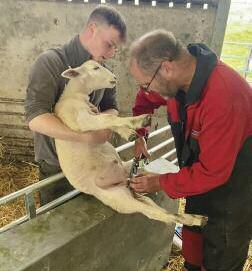
I i L K in
F
Stagehall Farm, Borders Stouslie Farm, Borders
“Getting the heifers in calf the first time for our customers is one of our main priorities, therefore the correct bull selection is paramount All heifers are BVD vaccinated, vaccinated with Bovipast, Braxxin 10 and a botulism vaccine on arrival
“We previously ran a flock of Cheviot Mule sheep but had to sell it due to the fact that we can’t get replacements in from Scotland since Brexit Now we are running a flock of 200 North Country Cheviots to build up and eventually breed our own Cheviot Mules,” he said
On-farm auction sales in Northern Ireland are mostly used for herd dispersals, usually dairy animals and for machinery sales. For James Alexander, it was the perfect solution to challenging logistics of moving so many head of sheep and cattle to marts frequently throughout the year
With the Covid-19 restrictions now very much over, James is back to selling his stock on the home farm, but continuing to use the digital sales arena as well for those potential buyers that cannot attend in person
James said: “We normally hold four heifer sales per year, but I want to cut this down a bit Usually we have one in
December, a large one in April, smaller one of 100 head in August and a larger one in October again
“Then we also have the gimmer sale with around 1500 sheep in July and the Jalex Genes Tup sale in August ”
With years of experience behind him, James knows a good beef animal when he sees one and uses a number of breeds to produce that top quality animal he is aiming for
He said: “We use a lot of cattle breeds with an emphasis on quality, and have a good reputation for selling well-shaped British Blue crossed Limousin heifers Also, we have Simmental crosses, Shorthorn crosses, which are less muscled heifers but it’s always the shapely ones that make the headlines and people see in the photos.”
James is quite tech savvy when it comes to using social media to promote his stock sales attracting customers from near and far
“The Covid-19 pandemic sped up the ability to buy livestock online and I was keen to use it,” said James “I had been using social media as a marketing tool for a long time and having the on-farm auction sale was an extension of this “Buying stock online is not for
everyone I know but the heifers we chose to put through the sales are top quality I want to give the person at home the confidence to either buy online or get them interested enough to come and see for themselves what I have on offer With every heifer being individually professionally photographed and videoed, the animal can be seen from all angles Plus, all info I have about each animal, including calving date, sire name and calf sex, is also listed ”
There is always a good atmosphere around the ring during the Jalex auction sales, which makes for a more comfortable environment for buyers
James said: “We have a good ringside attendance and we like the ringside being busy with some buzz and the folk picking their heifers.
“We also have a huge online following, many buyers and even more bidders, so it is very important to make sure our videos, description and photos are accurate
“I compile every description myself and don’t want someone buying anything online and the heifer landing home different than described ”
James added: “An on-farm sale is


c l i p fi t t e r . c o . u k n 2023 pioneering Scottish farmers have experienced the important benefits of ClipFitter: Instant Recovery, +DLWG, Later & Legal Tup Choice, Clean Repair Kinder Clip Castration and Tailing is legal in Scotland for a wide range of ages FIND OUT MORE Fit clips not rings www.farmingscotland.com farmingscotland.com on Facebook – farmingscotland on Twitter


more relaxing for the buyer as they get a chance to see round the farm and see what type of stock we are keeping It’s also easier on the stock with less haulage involved and the online bidding adds that extra boost
“Online bidding makes a huge difference as people can either bid on the day at the sale, or from their own homes, or they can leave a proxy bid




“We have heifers in the yard for all farmers as we have a large customer base that doesn’t need the heavily muscled heifers, just a good straight, soft fleshing, less high maintenance heifer
“Everyone’s opinion on what is a good suckler cow is different and it should be as we all have different set ups, different time constraints and
different end goals for what we produce ”
When it comes to the challenges of hosting an on-farm sale and the virtual equivalent, James admits to having many sleepless nights
He said: “I have lots of sleepless nights getting it all planned in my head Planning pens, what way will the cattle flow in and out of the ring, what to put where in the sale, what to put into the pens together, what order to put them in, all add to the hectic challenges
“However, it’s a team effort and good communication between us is so critical. We all have to be aiming in the same direction. I’m lucky to have a good team around as none of what we are doing can be carried out without it ”




10

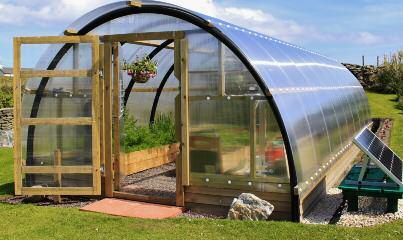


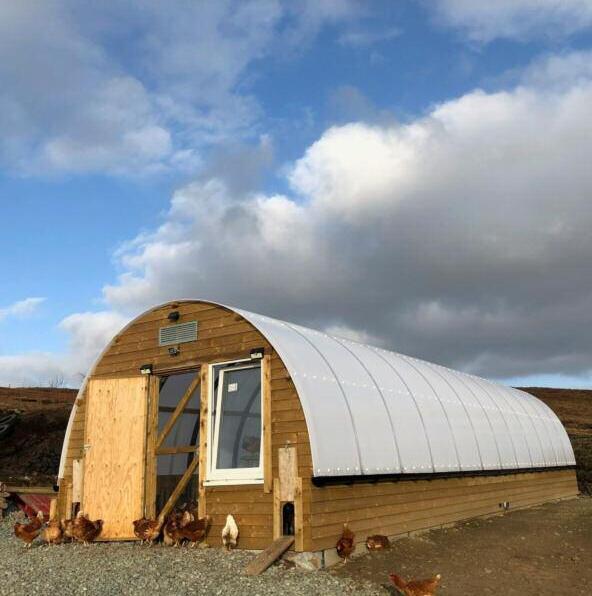
For more info contact Maree on 01806 335577 or info@polycrub.co.uk
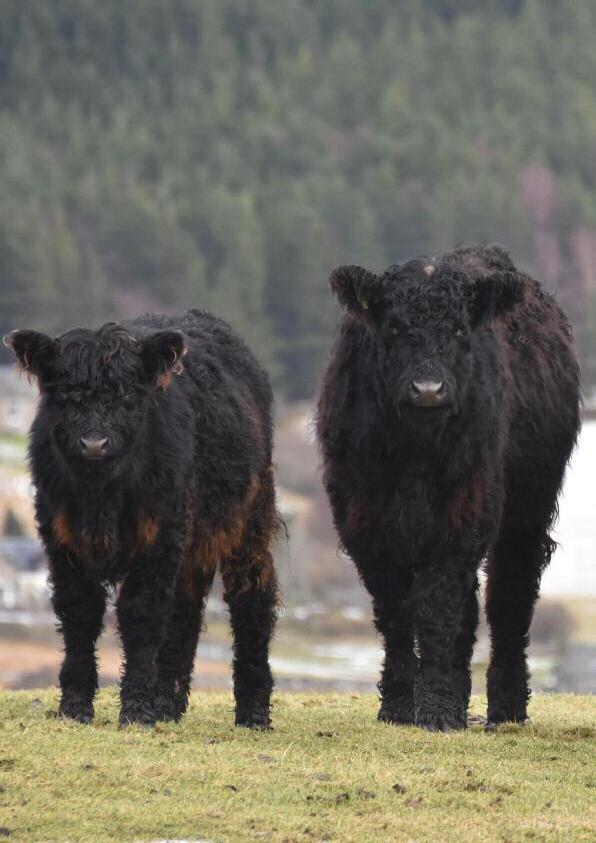
Farming and Conservation Grazing in Cairngorms National Park
 by Eilidh MacPherson
by Eilidh MacPherson
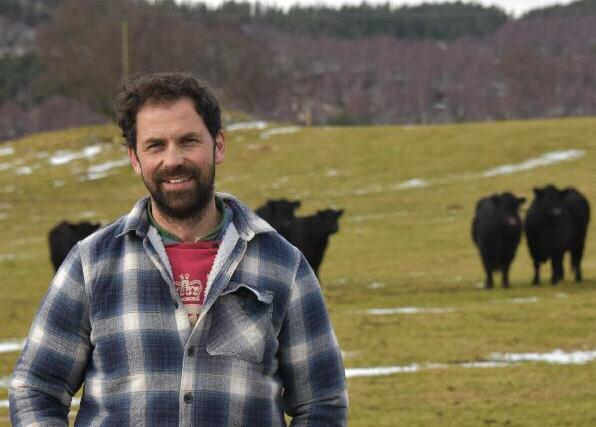
While farmers and crofters across the country are standing up against their areas becoming National Parks – we caught up with Bobby MacKenzie who farms with his sister June in the Cairngorm National Park.
Farming in a National Park has pluses and minuses say Bobby MacKenzie, who farms in conjunction with his father and sister by Boat of Garten and Grantown-on-Spey in the Cairngorms National Park
“One of the main is issues is that there are only two farmer representatives on the National Park Board. They have meant to be representing the farmers in the Park and getting the agricultural viewpoint across But if anything farming related comes up at a meeting, they are made to declare an interest, which totally defeats the purpose of them being on the board We have issues with that, as we as farmers struggle to get heard
“More than 50% on the board are government appointees I think seven
folk are voted on and eight are government employees There needs to be more local people on the board in my mind ”
“There is a rumour that the powers that be are trying to get rid of the board and have a joint one, with other National Parks, in Edinburgh. That just won’t work,” stated Bobby.
On the subject of peat land restoration the MacKenzies feel aggrieved that £12 5M has been spent by the National Park on regenerating peat bogs, while pupils at Kingussie High School have to move their desks so they are not under a drip!
“On the plus side the Park brings in more tourism and is busy year round, which is great for some businesses but puts pressure on others We find that
by Eilidh MacPherson
folk are phoning us constantly to say that a cow is calving or sheep lambing –it can be a bit endless
“The average price for a basic house in this area is £280K I don’t know any young local person who can afford to buy a house here
“When there is more snow Aviemore shuts two days a week, so staff can have time off, as they can’t get extra staff and find housing for them ”
Bobby is the third generation to tenant farm The Glebe, which covers 17 300 acres (7000ha) between the Spey and Dalnain rivers and the family have more recently taken on Wester Achnagallan – 5500 acres – on a contract farming basis Seafield Estates is the landlord of both holdings
Farming close to rivers is now a concern as the recent introduction of beavers into the Park has put the local farmers into a spin “We now have a Whatsapp group, which was set up to discuss the beavers No farmers had agreed to their release The beavers arrived while the debate continued ”
In December last year, beavers returned to the Cairngorms 400 years after the species was driven to extinction in Scotland A pair was released at
14
Farmers: Bobby MacKenzie and sister June in partnership with their father
Farming: The Glebe and Wester Achnagallan
Location: Boat of Garten & Grantown-on-Spey Caringorms National Park
Area: The Glebe – 17 300ac tenanted Seafield Estates Wester Achnagallan –5500ac contract farmed from Seafield Estates
Cattle: 150 suckler cows at Glebe 18 pedigree Galloways at Wester Achnagallan
Sheep: 2800 ewes on the Glebe: 500 cross ewes 500 Cheviot, rest Blackies 1200 ewes on W A
Crops: 60ac Barley 30ac Swedes 20ac fodder beets 100ac forage crop
Other: Bobby Chair of Highland Mule Association use of drone for gathering







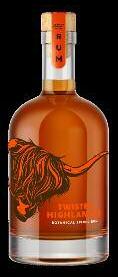
Award-winning Scottish Gin, Vodka and Rum, crafted in small batches from locally foraged botanicals on on the Hebridean Isle of Coll.

FARM FACTS
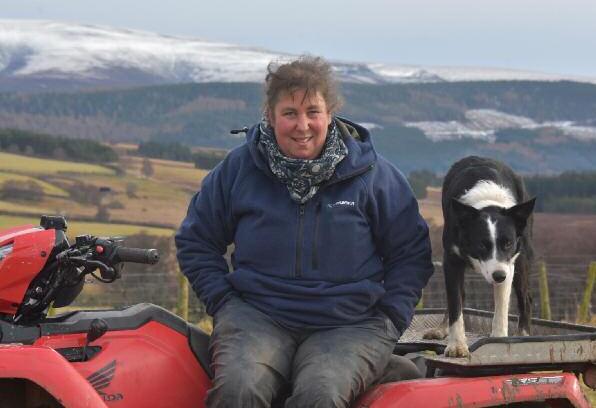
Rothiemurchus Estate, near Aviemore, another pair on land owned by billionaires Anne and Anders Holch Povlsen And a third pair at a site on the Insch marshes at Kincraig
“I don’t agree with the way they were put on us Money was spent on tree planting schemes to lower the temperature of the Spey for fishing It will be totally reversed by the beavers
“We have been offered payment for damage over the next three years, but my concern is not now, but in 20 years time, when they have multiplied in number,” commented Bobby, whose best in bye cropping and lamb fattening ground lies along the banks of the Spey
Running 150 head of suckler cows at The Glebe and having recently invested in pedigree Galloways at Wester Achnagallan, the MacKenzie’s have conservation grazings agreements with Seafield Estate and the RSPB All of the suckler herd are out-wintered and for the past few years seventy graze extensively in woodland
“Seventy per cent of the herd are spring calving and all the conservation cattle are spring calvers,” said Bobby
The cattle wear No Fence collars and can be tracked individually as to where they graze – eating heather and bramble bushes.
“The Galloways and Highlanders do the best job but surprisingly some Simmentals make the grade for a return visit the following year! We also have Shorthorns, Aberdeen Angus and cross Highlands,” commented Bobby, who is going more native with his breeds
No money changes hands, but the exercise is beneficial for both parties, with free grazing for the farmer and an increase in Capercallie and Black Grouse numbers for the landlords
“We haul the cattle ten miles to the woodlands and I check them once a week.”
Young stock for sale is housed. Stirks are sold through Aberdeen and Northern Marts at Thainstone
Until 2010 the MacKenzie’s ran a farm shop at The Glebe, selling their own home-grown beef and lamb “It was quite a tie and none of us wanted to spend all day in a shop,” commented June, who ran dog kennels for 20 years on farm before the opportunity to contract farm at Wester Achnagallan came up
There are currently five beasts ready for slaughter, finished on grass and barley and the team are considering selling boxed beef online
“When we took on the contract farm five years ago we wanted a small herd
of cattle to help with the LFAS payments We wanted something hardy and nice to look at and the Galloways fitted the bill,” commented June
The first six came from Balavil Estate, with three bred by Black Craig, two from Troloss and a Nether Cleugh
“From then on we have tried to buy one or two a year– Black Craig Noreen, Kirkstead Amber and Nether Cleugh Foxglove Blue and last year bought our first bull – Aoineart of Marbrack,” shared Bobby
The Galloway enterprise, which now numbers 18 breeding cows and heifers is being built up gradually. The siblings hope to run about forty head eventually Wester Achnagallan hill runs along the eastern side of the Grantown to Forres road – the A939 – until the turnoff for Nairn The hill ground is part of Dava Moor, which used to have open marches with neighbouring Tullcan Estate and Dunphail Estate
To protect nesting birds all gathering is done on foot and for the past three years, with the aid of an uncle on a drone! “He has it programmed with barking and whistling sound effects and the odd ***** swear word too!” smiled June
With 2800 ewes on the Glebe and a further 1200 at Wester Achnagallan this
16



www.farmingscotland.com
on Facebook – farmingscotland on Twitter
farmingscotland.com

hardy pair of siblings have their work cut out for them. They have found the Rappa portable handling system works well for them and as it is forty miles from the southern end of The Glebe to the northernmost point of the contract farm, they have one stationed at each steading ready for action where need be
“For about 80% of our sheep work we will take the Rappa yards to the flock, saving on time in walking them back to the fanks One set has a three way drafting race and weigh scales,” shared Bobby, who graduated from Craibstone SAC with an HND in Agriculture before coming home to farm
Blackfaces and Cheviots were bought in as tick moppers to protect the grouse for shooting on the estate at Wester Achnagallan.
Since taking over the contract farm, the extra land has also allowed Bobby to run a stud flock of 100 Blackface ewes to ”try and breed our own tups and sell a couple at Dingwall and Fort William We sold to a top of £850 and averaged £650 last year They are hardy hill types that have never been inside!”
“As we are in a tick area we thought
it would be easier to breed our own tups than have to buy in acclimatised ones. ”
The MacKenzies have found that since buying in stock for Wester Achnagallan there has been the odd worm flare up “We’ve been trying not to dose too often,” he added
Lambing started on 1st April in the fields and the hill sheep kick off at the end of April The hill ewes are all pure Blackface or Cheviot and their lambs go store through Dingwall
Old Blackface ewes are mated with the Bluefaced Leicester crossing types and true Blues cover the Cheviots Around four hundred mule ewe lambs are sold in one day at Dingwall The cross ewes are joined with Texels with their off spring sold fat, direct to Dunbia.
With good arable land on the banks of the Spey, the MacKenzie’s grow barley, swedes, fodder beets, stubble turnips and of course silage, using the bulk of the crops on farm, to be as self sufficient as possible
While the MacKenzies have been farming within the Cairngorm National Park for just over twenty years, many
farmers and crofters across the country are totally against their local areas falling under the National Park juristiction.
The Scottish Government is committed to designating at least one new park by 2026, to join Cairngorms National Park and Loch Lomond and the Trossachs National Park
The Scottish Borders, Galloway, Lochaber, Loch Awe and Tay Forest –are in the running to be Scotland's next National Park
Farmers and crofters on the Isle of Skye stood strong against the Island becoming a National Park “There will be an extra layer of bureaucrecy, the infrasturcture on the island is poor and we are over run with tourists as it is,” commented John Angus McCusbic who farms at Totarder, Struan, before Skye was ruled out of the equation. These reasons are echoed by John MacPherson of Balliemeanoch, Portsonachan, Loch Awe for the proposed Argyllshire Park
John Angus set up a ‘Skye National Park No More!’ Facebook page
Lochaber have done likewise and a petition – PE2089: Stop More National Parks in Scotland – had 2035 signatures
18




19 DM (Agri-Supplies) Ltd AGRICULTURAL MERCHANTS SPECIALLY FORMULATED SUPPLEMENTS FOR THE HIGHLANDS. Contact Douglas 07713 723 899 douglas@dmagri.co.uk DM (Agri-Supplies) Ltd GRICULTURAL MERCHANTS DM (Agri-Supplies) Ltd AGRICULTURAL MERCHANTS G e o r d i e D u f f Agricultural Merchant for all your Requirements Full range of LS Smellie & sons Ltd Cattle and Sheep Feeds & Straights Sheep Drenches Yara Fertilisers Pleased to be supplying the MacKenzies at The Glebe & Wester Achnagallan Call Geordie on: 07785 278908 Highland Mule Breeders Association For Hardy Healthy Breeding Mules Annual Sale of Gimmers & Ewe Lambs At Dingwall & Highland Marts Monday 9 September 2024 All sheep forward for sale : • HISHA Accredited free from enzootic abortion • Plunge dipped in Scab Approved dip within 14 days of the sale • Fully vaccinated against Clostridial diseases • Fluke Dosed • Ewe Lambs dosed with wormer within 4 weeks prior to sale • From Farm assured Flocks Secretary – Muriel Ross – 07713 358539

Being much more specific about recording lamb losses at one of Scotland’s Monitor Farms has prompted an innovative new lambing health project.
With lambing being one of the busiest and intensive periods on a livestock farm, there often isn’t time to take stock of what is happening until long after the event And when lambing is less successful than hoped, it can be difficult to identify why
While it can be disheartening to even think about recording ewe or lamb deaths and the reasons for them, attendees at a recent Monitor Farm Scotland meeting at Wallets Marts in Castle Douglas heard how it had helped identify issues on-farm and prompted action to tackle them, as well as inspiring a new research project.
Meeting attendees heard that Dumfriesshire Monitor Farmer Richard McCornick and his family, who run the 200ha (500-acre) beef and sheep unit at Barnbackle, had used data to identify flock performance issues Sheep numbers have increased this year with 800 ewes and 150 ewe lambs to the tup, so there is a particular focus on improving performance The farm’s Integrated Land Management Plan, produced by SAC Consulting as part of the first year of this Monitor Farm programme, highlighted lambing losses as an area for attention
Ayrshire Monitor Farm Stewartry Vets Explore Boosting Lamb Survival
As a result, a flock tally sheet recording losses on a whiteboard in the lambing shed helped the farm identify the main causes of loss To tackle these, Richard is going to focus on ewe nutrition and health, colostrum quality and lamb immunity.
It has also led to a deeper investigation into colostrum quality and failure to transfer passive immunity from ewe to lambs The collaborative project between Monitor Farm Scotland, Livestock Health Scotland and run by The Stewartry Veterinary Centre and University of Glasgow, will involve a holistic approach, says vet and researcher Ali Haggerty, who is Barnbackle’s vet
“We will be looking at ewe body condition score and nutrition, then sampling ewe colostrum and blood testing their lambs to see how that marries up, as well as investigating lamb deaths.”
The ultimate aim of the project is simple; to increase lamb survival rates, producing more lambs for sale, she says.
“The whiteboard at Barnbackle highlighted that quite a lot of the lamb losses were around lambing, from things such as watery mouth or joint ill Lambs are born without any antibodies, so they rely on that first few hours of receiving colostrum from their mother for immunity to disease in the first few weeks of life We think that if we can look at improving their immunity, we will have more, healthier lambs on the ground ”
While she cautions that the study will only be a snapshot in time, she says there are some key areas of focus
Looking at ewe nutrition will be key, assessed through consistent body condition scoring throughout the year and metabolic profiling at key times, particularly two to three weeks before the start of lambing This will look at whether the available feed is adequate and being utilised fully by ewes This is vital to produce enough high quality colostrum to feed their lambs in the first few hours of life
“The lamb’s gut is only permeable to the antibodies from colostrum for the first six to twelve hours of life By 24 hours old, the channels in the gut wall
have closed completely, so colostrum at that time will not be absorbed into the body and provide local gut immunity at best It’s also a high fat product, which is crucial for lambing outside –providing energy to keep warm. There is a lot in it to give lambs the best start, so proper colostrum management is important,” she says
Taking colostrum samples from ewes, and later, blood samples from their lambs will assess whether the lamb has adequate passive transfer of immunity
All of that data, plus details of the ewe and her lambing performance collected by vets and vet students, will be collated, with results expected to be available in early summer
“We aren’t changing too much on the farm this year and in the run up to lambing as we want to capture what is going on and to be able to assess that While Richard lambs indoors, I expect some aspects of the results to be equally applicable to outside lambing and I think it will focus attention on just how important colostrum is.”
Barnbackle is one of nine Monitor Farms across Scotland taking part in the programme run by Quality Meat Scotland and AHDB and funded by Scottish Government This aims to help farms reach full economic, social, and environmental sustainability by optimising production Over the four year project, other farmers and experts will be brought together to help the businesses assess farm performance, explore opportunities and develop solutions to their challenges
Livestock Health Scotland (LHS) is a ‘not for profit’ producer-led organisation focused on building the health and welfare status of Scottish livestock. It aims to work in partnership with livestock producers and farm vets to achieve this, and also aims to be a bridge between researchers, systems experts and those operating at farm business level, creating a pathway for innovation
LHS’s activities include: Maintaining active two-way communication with producers and farm vets; providing information and technical guidance in collaboration with expert groups; supporting smarter disease management strategies at farm and
20
Lambing Shed Artwork Urges Farmers to #KeepTalking
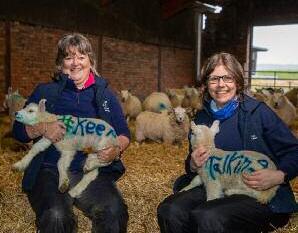

Scottish agricultural charity RSABI is reminding people in farming communities of the importance of checking in on each other at this very busy and often challenging, time of year
In the latest of a series of initiatives behind its #KeepTalking campaign, RSABI is encouraging people to try find time, even during lambing, calving and sowing, to look out for each other
Working with the Scottish Association of Young Farmers Clubs (SAYFC), the charity is publishing social media posts highlighting the vital #KeepTalking message along with SAYFC's powerful AreEweOk? message.
The initiative, aimed at everyone involved in farming, features RSABI Trustee Carole Brunton, RSABI Health Hut nurse Irene Scott, and SAYFC Vice-chair Ally Brunton, with lambing shed artwork Over the past few days, the social posts have achieved a reach of over 150 000 on Facebook alone
RSABI's ongoing #KeepTalking initiative aims to encourage those living within Scottish agricultural communities to reach out and reconnect
with loved ones, neighbours and relatives if feeling isolated or lonely
and Ask #AreEwe OK?
"It's particularly important at this time of year, when everyone is starting to be busy with spring work and weather conditions are often against us, for the farming community to stay connected and look out for anyone who may be struggling
"We know there are some really tough days and that some people can find life difficult Things can be hard and it is very easy to start to be overwhelmed when you are working flat out and not getting enough sleep," said Carol McLaren, Chief Executive of RSABI.
"When we bottle things up, we start to lose perspective and we can blame ourselves for things that are not our fault and it is therefore more important than ever to find time to talk with other people, and be kind to yourself too
"RSABI is also here for everyone working in Scottish agriculture and our Helpline 0808 1234 555 is open 24/7
Our free counselling service has never been busier, with approaching 1000
counselling sessions arranged this year, and this is quick and simple to arrange "
Penny Mongomerie, Chief Executive of SAYFC, said: "We know that this busy time of year, when there tend to be fewer events taking place and less socialising opportunity, can be really difficult and it is too easy to lose contact with each other We're pleased to be working with RSABI to remind people to check in on each other and support one another – whether via social media, phone calls or a quick visit when time allows. Finding time for even a small gesture of support can make a big difference."
RSABI offers free practical, financial, and emotional support including counselling services, delivered quickly after receiving the initial enquiry Its free confidential support service is available 24 hours a day, every day of the year, by calling 0808 1234 555, calls won't show up on phone bills, or through a confidential webchat service, available on RSABI's website www rsabi org uk
21
Keep People Safe From Asbestos Top Chef Cooks up Interest in British Red Meat and Dairy
Buildings that people use in their daily lives, such as workplaces, schools and hospitals are the focus of a new campaign to keep people safe from asbestos.
Asbestos: Your Duty, aims to improve understanding of what the legal duty to manage asbestos involves
The Health and Safety Executive (HSE) wants anyone with responsibilities for buildings to do everything they must do to comply with the law and prevent exposure to this dangerous substance, which was widely used in post-war construction before it was completely banned in 1999
The legal duty to manage asbestos covers a wide range of buildings such as museums, schools, hospitals and places of worship, as well as workplaces like offices and factories
Businesses and organisations responsible for premises built before the turn of the century, and especially those between 1950 and 1980 when the use of asbestos in construction was at its peak, must carry out the necessary checks and understand their legal responsibilities
People who visit or work in these buildings will not be exposed if asbestos is properly contained But it can become dangerous when disturbed or damaged
Updated information, new templates (including an asbestos management plan template), and explanatory videos can be found on HSE’s website to help anyone who is unsure of their legal duties – or just need to refresh themselves – on what they need to do
HSE will check how asbestos is managed when visiting a range of buildings – like schools and hospitals –requiring those responsible for managing asbestos risks to ensure they have the right arrangements in place
Sarah Albon, HSE’s chief executive said: “To keep people safe from the harms of asbestos, a culture of safely managing asbestos is needed in our building industry and among those responsible for buildings
“Asbestos exposure in Great Britain is still the single greatest cause of work related deaths due to exposures decades ago
“Together, we must protect people in the workplace and reduce future work-related ill health ”
British red meat and dairy have been making their mark in Singapore with the help of the executive chef from two-Michelin star restaurant JAAN
Kirk Westaway headlined an exclusive Singapore meat and dairy chef's demonstration organised by the Agriculture and Horticulture Development Board (AHDB)
Twenty-one chefs from Singapore representing some of the top restaurants attended the event, which showcased pork, lamb and dairy dishes, including tastings of five different British cheeses. AHDB analysis has highlighted opportunities for British red meat and dairy in the Singapore foodservice sector, with consumers attracted to premium cuts of red meat and premium products such as cheese, alongside a population that eats out often
Lucy Randolph, AHDB Head of International Trade Development (Dairy), said: "Singapore is an important dairy importer in the region, presenting opportunities for premium British products We had a phenomenal event with Kirk Westaway showcasing British dairy and meat dishes to 21 chefs from around Singapore The response was fantastic and we look forward to them taking inspiration from the day and promoting British dairy and meat in the wider Singapore foodservice sector."
Susan Stewart, AHDB Senior Trade Development Manager, said: "Our levy payers produce high quality products that we are proud to fly the flag for on the global stage The Singapore meat and dairy showcase provided a fabulous opportunity for industry professionals to taste, enjoy and appreciate the taste and quality of British pork, lamb and dairy and build the reputation of our products in this important and growing market "


Ireland's Remot Network Could
Researchers at Scotland's Rural College (SRUC) have been awarded nearly £12 500 to investigate the impact of remote working hubs on rural areas.
The project, which is being funded by the Royal Society of Edinburgh and Royal Irish Academy, will look at the development of more than 300 remote working hubs in rural Ireland over the past decade and explore the scope for a similar model in Scotland
Various studies have shown that the national ConnectedHubs network in Ireland has had a positive impact on rural communities and offers opportunities for future economic development While Scotland faces similar rural challenges to Ireland, no equivalent network exists here
The project, led by Dr Ian Merrell and Anna Sellars, will explore how the Irish networks were established and who was involved in their development in order to identify best practice example hubs and network activities which could be replicated in Scotland.
It will also highlight outstanding research and information gaps –particularly with regards to evaluating longer-term impacts and future development opportunities for rural
22


Electrical weeding — Lazarus Technology for Weed Management
te Working Hubs
Benefit Scotland
areas
And it will establish potential strengths, weaknesses, opportunities and threats of putting a remote hub network into practice in Scotland, considering economic, social, logistical and environmental factors.
An important aim of the project will be to identify ongoing research opportunities, combining Ireland's strengths in enterprise and remote working with Scotland's focus on the natural economy and net zero policies in rural areas
Anna, Senior Consultant with SAC Consulting – part of SRUC, said: "While Scotland faces many similar rural challenges to Ireland – such as depopulation, maintaining rural services for a local community, challenges from tourism and shortage of affordable housing – no network of remote working spaces exists in Scotland, and professional work opportunities remain centralised in major cities."
Ian, Research Fellow with the Rural Policy Centre at SRUC, added: "This project will explore what stakeholder engagement, at a local and national level, as well as policy and enterprise involvement, would be required to pilot a similar network in Scotland
Herbicides are on an ever downward spiral due to evolved resistance, lack of new chemistry, legislative headwinds and consumer resistance. New weed management tools are desperately needed to replace them but few non-chemical approaches have the same simplicity of use, efficacy and flexibility of herbicides However, electrical weed management is increasingly proving that it can be a direct replacement for herbicides
First conceived and patented 140 years ago, it had its previous heyday in the 1980s before being killed of by the then new fangled glyphosate But with the increasing headwinds facing glyphosate and other herbicides, electrical weeding is well and truly back from the dead. There are also some of the biggest names in agriculture, both machinery and chemical, such as Case IH, John Deere and Nufarm, buying into electrical weeding companies, further indicating the technologies potential
Electrical weeders are also vastly more advanced than those from the 80s with sophisticated computer control systems that further improve the tech's efficacy and efficiency This means there is a lot to understand about the whole technology, individual weeders and the role of plant morphology
Therefore to help farmers, growers, other land managers as well as scientists understand electrical weed management the BHU Future Farming Centre (FFC) has just published "A comprehensive Guide to Electrical Weed Management"
free to download
https://www.bhu.org.nz/future-farming-centre/information/bulletin/2024v1-a-comprehensive-guide-to-electricalweed-management/ .
Written by the head of the FFC Dr Charles 'Merf' Merfield who is a world leading expert on thermal weed management, which includes electrical weed management
Dr Merfield says "Electrical weeding is proving to be a game changing technology that is looking like it will provide alternatives to herbicides Depending on the application method, it can be used to take out taller than crop weeds, especially those that have resistance and otherwise escaped herbicide control Most importantly it can be a direct replacement for glyphosate i.e., 'Roundup®' for eliminating all vegetation in a paddock thus allowing non-chemical/organic no-till/direct drilling. It's also being used on robotic weeders to individually kill weedlings in vegetable crops, entirely replacing herbicides "
Dr Merfield also said "that many people think electrical weeding is going to be really energy intensive, which in a climate change world, would rule it out But that's just not correct, Electrical weed management already uses less energy than boom applied herbicides –taking into account the energy embodied in the herbicide as well as the diesel burnt in the tractor applying it to the paddocks Further technological advances would make it the lest energy hungry form of weed management of all."
23


Importance of Old Farm Buildings for Bats
Within Scotland, we have nine species of bats that patrol our night sky, using echolocation to navigate and seek out insects They do this very successfully, with a single bat capable of eating up to 3000 midges and other small insects in a single night.
When not flying and hunting, bats require shelter that is dry, safe and the right temperature – this is referred to as their roost Within a natural environment, these roosts could be found in old trees, caves and rock fissures However, as human societies developed, removing these natural features to build homes and buildings, bats have adapted to making roosts within our buildings
Old farm buildings with gaps, cracks and vacant roof spaces will provide a range of conditions ideal for the different roosts bats require throughout the year
The bat species in Scotland that use buildings to roost can be divided into three different categories:
• Crevice-dwelling bats – Common pipistrelle, Soprano pipistrelle, Nathusius pipistrelle and whiskered bat
• Roof dwelling bats – Leislers bat and Daubentons bat
• Bats that need flight space in certain types of roosts – Natteres bat and brown long eared bat
Each species requires a variety of roosts, offering different conditions, throughout the year The most common and important roosts are:
• Day roost – A place where individual
bats, or small groups, rest or shelter in the day during the summer These are used during the active summer months, usually frequented by males while the females form maternity roosts
• Maternity roost – A place where females give birth and raise their young to independence. In some species, males may also be present in the maternity roost. These occur in early summer and generally require warm dry conditions between 30-40°C
• Hibernation roost – A place where bats may be found individually or together during the winter Bats begin to hibernate around November, and look for cool humid spaces, where they drop their body temperature and begin hibernation
Farm buildings offer many different conditions and so can support multiple species of bats, as well as multiple kinds of roosts
Many crevice dwelling species, such as pipistrelles, do not require large openings to use as roost spaces. To the contrary, bats can fit into holes as small as 1.5cm x 2cm and smaller entrances which prevent water from entering and heat escaping can be preferable to bats
Small cracks and gaps in stone walls could provide enough room for a roost of a couple of bats, or alternatively provide access into a building where many bats can access a larger space
Cavity walls within buildings can also provide suitable conditions for bat roosts A crack in the exterior wall or a door frame could allow bats to access
 by Harry Fisher SAC Consulting
by Harry Fisher SAC Consulting
these areas They also often provide stable cool conditions, offering perfect conditions for hibernation roosts for bats
Loft spaces in farm buildings can provide roomy warm conditions for pregnant females to gather, give birth and raise their young. These can often be accessed from gaps in tiles, loose soffits vents or loose bricks above the roof space The presence of bats within a building can be observed by looking out for emergence around dusk during the summer or checking for droppings in and around potential entrances It is important to do these with care to avoid disturbing any potential bats roosting
All bat species in Scotland are protected by law This means it is an offence to damage or destroy a roost site, be it a maternity, hibernation or day resting roost It is also an offence to disturb a bat while it is in a roost, be it deliberate or recklessly
If you find your farm buildings contain some of the features listed above as being beneficial for bat roosts, there is a chance you may already have a roost within the building. The best thing you can do is to make sure these potential roosts are left alone, especially during maternity periods where disturbance can have the greatest impact to young pups Alternatively, if you want to provide roosts for bats on new buildings lacking these features, bat boxes can be installed to provide space for the different roosts required for bats throughout the year
24

RHASS Celebrates 240 Years
Scotland’s agricultural charity, Royal Highland & Agricultural Society of Scotland announced a programme of family-friendly events throughout 2024 to celebrate its 240th anniversary
They range from a cuddly toy sheep scavenger hunt over the Easter holidays to a mass Munro challenge, Harvest Thanksgiving service to a yearlong audio and visual storytelling project
The planned activities all aim to raise greater awareness around key times in the agricultural calendar, unheard stories from across the sector and issues that face the rural community and will all generate funds for land initiatives preserving Scotland's countryside
The celebrations kick off over the Easter school holidays with a nationwide scavenger hunt Hide & Sheep Thousands of cuddly toy sheep will be hidden across the 8 regions of Scotland, from Shetland and the Outer Hebrides to the lowlands of the Scottish Borders. Once found, the sheep can be kept by their new owners. With each sheep found, there’s a chance for the discoverer to win a VIP trip with their family to the 2024 Royal Highland Show – but only 8 of the flock hold this special prize! A celebration of community and tradition, the campaign will also share information with the new sheep owners of the importance of the spring period in the agricultural calendar, sharing insights on lambing, crop sowing and more
Throughout the year, RHASS will be
bringing their rich history to life through 240 Years of Stories Partnering with Scene & Herd and their new series of podcasts, OnRecord and media partner the Scotsman Group collecting meaningful stories from Scotland’s rural community and shared through multiple media platforms throughout the year. RHASS aims to showcase their profound influence on countless lives and society in Scotland over the centuries, highlighting pivotal moments and acting as a form of remembrance, connection, and celebration for generations past, present and future
On September 21st, RHASS’ Mighty Munro Muster will see teams across Scotland conquer all 282 Munros within a daring 12-hour window The mass participation fundraising event will involve over 600 participants working in unison to scale every Munro in the land in support of RHASS and Scotland’s rich rural heritage
To mark another key milestone in the agricultural calendar, RHASS will hold a number of Harvest Thanksgiving Services across Scotland and will again join the congregation of St Giles Cathedral in Edinburgh to celebrate, while also marking their 900th anniversary – these will offer a time to reflect on the year and years gone by and celebrate the successful harvest and hard work undertaken every year to deliver food to the nation
RHASS was formed in 1784 to promote the regeneration of rural Scotland, as well as the preservation of
Cuddly Toy Sheep Hunt
its poetry, language and music The charity has been instrumental in supporting the advancement of agriculture and technology and in those years, as early as 1800s RHASS campaigned to standardise weights and measures. Around the same time the Society worked alongside famed Scottish Civil Engineer Thomas Telford in commissioning reports and surveys to support the creation of the Caledonian Canal between Inverness and Fort William
Jim Warnock, RHASS Chairman said; “The 240th Anniversary year is a huge milestone for RHASS – and we hope that these events will resonate with people across Scotland by learning something new about agriculture or the work of the Society itself This year of events celebrates the achievements made over 240 years of the Society and marks the beginning of the next 240 Furthering support and advancement of the agricultural sector in Scotland ”
Alan Laidlaw, RHASS CEO added: “Our long history of championing Scottish agriculture will be on display this year as we take RHASS on the road. Inspiring the next generation through events like Hide & Sheep, recording and collating our oral history through members of our community young and old in 240 Years of Stories or in conversations between colleagues and friends hiking up a Munro RHASS has always been rooted in community and it is them that we commemorate in this anniversary year ”
25

While most women turning 50 may change their image, take up a new pastime or travel, Scottish sheep shearer, Una Cameron (51), is a bit left field as she is having a crack at the Women’s nine hour Strong Wool World Shearing Record!
Now in her 29th year as a professional sheep shearer on the world circuit Una has shorn across the UK, Australia, New Zealand and Norway
“I’ve decided to do a world record this year It is something that is always on your mind as a shearer – every shearer ’ s dream.
“I never thought I was good enough but my friends and peers from the industry have pushed me to attempt it in August and with their support I know I can do it,”shared Una, who has been in training since August 2023
Personal sports trainer, Max Luxton, who has trained over ten World Shearing record holders has been
putting Una through her paces
She flew out to New Zealand in the backend to shear for the season and is now home till the end of April, before heading to Cornwall to work for Matt Smith for six weeks
Then it is home to the Borders and partner Geordie Bayne, who is no stranger to the shearing world, winning the World Team title in 1996, in Masterton, New Zealand, teamed with fellow Borderer Tom Wilson
The couple operate a shearing run across the Scottish Borders, employing young local siblings Sophie and James Smith.
With several female records being attempted in New Zealand over Christmas and into the New Year, Una waited to see what her Kiwi cohorts tallied before she decided to go for the eight or nine hour record Following Sacha Bond breaking the nine hour ewe record, in February, clocking off with
for
by Eilidh MacPherson

26
Ewe
Una Going
Nine Hour Women’s World Strong Wool
Record


discover your future at scotland’s rural college Places
available on courses
in September 2024. Find us on Facebook www.sruc.ac.uk/opendays @srucstudy @sruc SRUC is a charity registered in Scotland: SC003712
still
starting
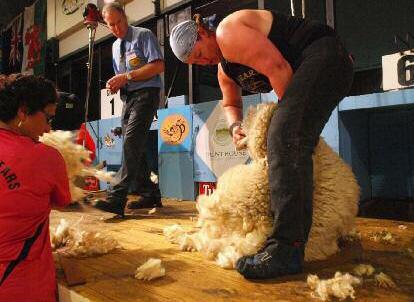
458 on the counter Una decided that is the one she wanted to better “The 9 hour is the old school record that everyone always wanted – it was seen as the cream of the records ”
She first lifted a handpiece while at studying agriculture at Borders College and loved it “My Uncle Rob Baxter used to help me get some practice shearing each summer ”
After gaining an OND at Oatridge College (now under the SRUC umbrella), where the late Dave Turner was a huge influence, she worked at Over Langshaw for 18 months and then decided to take shearing up full time and started travelling the world in 1995
“I found in the early years being a female shearer was quite difficult as most people assumed that you would be doing the wool when you walked into a shearing shed anywhere in the world

“Most of the men I have worked with have been great, but some have had the attitude that it is no place for a woman, or no job for a woman But I feel over the years I have maybe proved them wrong, ” stated Una, who is the only female shearer in the world to make the coveted Top 30 in the sixty year history of the New Zealand Golden Shears and the only lady in the UK to be promoted into the Open grade to shear against the men.
“Nowadays there are probably more women coming into the industry than there are young men They are proving themselves – there are some very good females shearers out there now and it is great to see It is not the lonely job that it used to be!” she quipped
Una is a talented welder and when she is not busy shearing she enjoys making and selling things out of


horseshoes The couple are into horse riding and try to take part in the Common Ridings every summer, although it is during the busy shearing season.
The tradition of common riding dates back to the 13th and 14th centuries, when Scotland and England were continually warring It was a Border Country custom to plunder and thieve cattle, known as reiving The local laird would appoint a leading townsperson, who would then ride the burgh’s boundaries, or "marches," to protect their common lands
Una's record will take place at Pip & Matt Smith's farm – Trefranck Farm, Launceston, Cornwall – on August 7th 2024 and she will be shearing strong wool Romney ewes
For a world record the sheep have to have a top-knot and belly wool and an
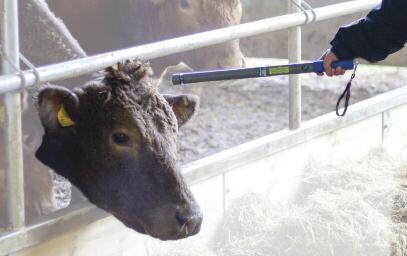

Call 01643 841611 Full range online www.shearwell.co.uk like a
average wool weight of 3kgs. Prior to the event several sheep will be shorn and the wool weights recorded.
Four World Record Sheep Shearing Judges – three from the UK (Andy Rankin, Mark Fox and Martin Davies) – and one from the Southern Hemisphere (TBC) will oversee the event, which will be live-streamed round the world
New Zealander Matt Smith, who currently holds the 9 hour men's strong wool world record of 731 sheep, shorn on Trefranck Farm, will Una’s second/time keeper for the record
A team of forty friends and fellow shearers from as far as New Zealand will be helping out on the run up and on the day
So far premium sponsors of the event include Heiniger supplying all the shearing gear and singlets, the British Wool Marketing Board, Howden Rural and Swanndri (tbc)
Other sponsors: Polycrub, Southdown Duvets, NFU Mutual, Clipfitter, Shearwell, Horner Shearing, Tiny Home, Oatridge College – SRUC, JNE Engineering, Maunders & Sons and Little Park Farm. Several others are in the pipeline.
Anyone interested in sponsoring the record please contact Eilidh MacPherson at editor@farmingscotland com or Marie Prebble at marie@kentshepherd co uk

















ium - perfect if you smaller primary tag SET Tags Excellent Retention Ask about FREE replacement Combi ® Medium N.Scotland & the Isles Jane Thomson 07788 209 438 S.Scotland James Hickson 07714 744 686 Call your local rep: All prices exclude VAT & delivery Breeding pairs from Slaughter tags from 98p 75p Photos this Issue: Page 3 – top Alfie Shaw Page 4/10 – Alfie Shaw Page 20 – Stewartry Vets Page 21 – RSABI Page 22 – AHDB Page 22 – SRUC Page 23 – Provided Page 24 – SAC For more information 01822 615456 | info@mudgeshearing.co.uk www.georgemudgeshearing.co.uk GEORGE MUDGE & CO. SHEEP SHEARING EQUIPMENT SPECIALISTS Everything you need to attend a shearing course. Available to order online or please call. SHEARLING COURSE/STARTER KIT NEW - MOBILE SHEAR PACK COMBS & CUTTERS CLOTHING Designed by us - you can now shear any where at any time, with this easy to carry back pack We carry a large range of combs and cutters for all of your requirements. British made Vests, Trousers, Mocs and Smock Jackets. Find us on facebook for news & special offers Established over 40 years ago in the sheep and handling business. Expert advice and prompt attention given to all enquiries. We hold a large stock of everything for the shearer.
Page 25 – RHASS
26 – Provided Page 38/41– Provided
42 – Krone
44/49 – C McCullough Page 50/51 – Claas Page 52 – Case IH Page 53 – Provided Page 56/58 – Petra Jacob
-
Page
Page
Page

British Wool Update
by Gareth Jones, Head of Member Engagement, BWMB
As a farmer organisation, British Wool is committed to supporting the UK agricultural and shearing industry. In 2023 we had more than 850 attendees on our shearing and wool handling courses and this year we are hoping we’ll see even more participants
In 2023, we were delighted to support the World Shearing & Wool Handling Championships in Edinburgh This event was a fantastic showcase for the industry and British Wool was proud to be a mainline sponsor Congratulations to all those who competed and a special mention to our World Champions; Gwion Evans - Machine Shearing World Champion, Rosie Keenan - Wool Handling World Champion, Gwion Evans & Richard Jones, Team Machine Shearing World Champions and Ffion Jones & Sarah-Jane Rees - Team Wool Handling World Champions.
We’ll be running well over 100 courses this year across the UK Training will be provided to beginners who may never have even handled sheep before through to advanced shearers looking to refine their technique
British Wool is delighted to support young farmers to take up shearing and
this year any member of a Young Farmers Club was eligible for a 50% discount on course fees if they applied before the 31st of March deadline. This applied to beginner, intermediate and advanced courses Supporting the next generation is key to a strong and thriving industry
Demand for British Wool is strengthening We’ve seen significant growth in the number of licensees over the last year At the time of writing, we have 140 brands and manufacturers specifying British Wool for their products
Most of the wool we sell on behalf of our members is processed in the UK, with smaller amounts being processed in Europe and China The team is working with brands to underpin demand and differentiate our wool from the global commodity market.
The provenance of British Wool is becoming more important and represents an opportunity to increase its value for members Brands and consumers increasingly care about Ethics, Sustainability and Quality when it comes to sourcing their products These attributes play to British Wool’s strengths; we have high welfare and environmental standards in the UK and
our grading system ensures that we are selling a high-quality product into the market.
Our marketing success has also been underpinned by the introduction of traceability All the wool we sell is now traceable back to farm and we have more than a dozen brands paying a premium for this service Brands such as Woolroom, Harrison Spinks and Laxtons have fully traceable British Wool ranges This is creating additional value and supporting the returns for British Wool’s members
We are also working to build consumer awareness for wool in general and British wool in particular We’ve successfully increased the number of articles written about the benefits of wool and support organisations such as the Campaign for Wool and the International Wool Textile Organisation in taking these messages to a global audience We have a great product and need to fight back against the synthetic fibre industry
May I wish those of you exhibiting at any shows this year the very best of luck
Many thanks for your continued support for British Wool
30
B ritish Wool –training the next generation of shearers and
wool handlers
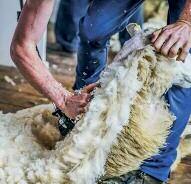
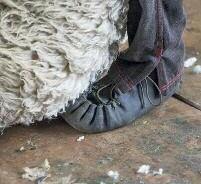

For over 20 years British Wool has provided four stages of shearing certificates enabling UK shearers to safely and effectively shear British wool.
Providing an exclusive training offer to the young farmer movement to help encourage more young farmers into the field.
Bronze to Gold courses in shearing and wool handling are now accredited by Highfield – a global leader in work-based and apprenticeship qualifications.
Working in partnership with key stakeholders –supporting the UK shearing sector.
To find out more call us on 01274 688666 or email shearing@britishwool.org.uk britishwool.org.uk
Together we’re growing something special.


New Zealand Shears –Powered by Wool
by Doug Laing
Woolhandlers have had their day in the sun with three national titles decided on the opening day of the New Zealand Shears shearing and woolhandling championships in Te Kuiti today (Thursday)
For all three it was the only win of the 2023-2024- season, although it was the third big one in the career of Senior final winner Rahera Kerr, of Hauturu, who won the Junior title at Te Kuiti in 2021, graduated as No 1-ranked Junior for the season and won the Golden Shears Senior title in Masterton last year
She was also runner-up in last year's Te Kuiti final, but, no longer working in the woolsheds, a 34-year-old focused on raising a young one with "one on the way", still has just the two wins in the grade.
She won by 10 points from runner-up and 2024 Golden Shears champion Vinniye Phillips, of Taumarunui, last season's No 1-ranked Senior who, now with six wins in the bag, is expected to join sister Te Anna in the Open grade next season
"Winning in one grade (at the New
Zealand Shears) and doing it again in another grade....It's cool," she said, although it might be at least cool following the path of partner James Ruki, who was a surprise 5th in the Golden Shears Open shearing final last month and on Saturday hopes for even better in the NZ Shears Open in front of his home crowd
The Junior woolhandling title was won by Rongomai Hepi, of Taumarunui, and the Novice final was swept up by Waitara teenager Arleigh Tamati, each contesting a final for the first time
Te Kuiti woolhandler Keryn Herbert, who represented the Cook Islands, at 2023 World Championships in Scotland, was the best performed Southern Hemisphere woolhandler She is favourite to win the Open woolhandling title after qualifing in top spot for Saturday night's final.
A former multiple World Championships and TransTasman' series New Zealand representative, she's won 56 finals in 21 seasons in the Open class, and has been acclaimed a Master Woolhandler, but is yet to win either the New Zealand Shears or Golden Shears
Open titles.
Defending champion Angela Stevens, daughter of Johnny Kirkpatrick, of Napier, was eliminated in the semi finals and 2021 winner Pagan Rimene and four-times winner Joel Henare, who have each won competitions this season, were not in the field
Herbert, who has won five finals during the season, will be joined in the final by Napier woolhander Jasmin Tipoki, who has had two wins this season, third-qualifier was Chelsea Collier, from Hamilton and who had her first win of the season at the Hawke's Bay Autumn Shears in Waipukurau on Wednesday, 1996 Senior champion and Taumarunui woolhandler Miriam Haig, who has had one win in a comeback this season, and 2013 Open winner Hanatia Tipene, of Te Kuiti.
The woolhandling attracted 84 entries across the four grades, comprising 19 in the Novice event, 25 juniors, 11 seniors, and 29 in the Open grade
Meanwhile, 61 shearers later took part in the Open and Senior speed shears, which were particularly tough going for some of the top guns
32
Golden Shears speed shear winner Paerata Abraham, of Masterton, and Ozzie-based Taumarunui shearer Floyd Neil, who won the A$20 000 Oberon speed shear in New South Wales, were both eliminated in the Open heats New Zealand Rural Games speed shear champion Jack Fagan, Te Kuiti, was ousted in the semi-finals, after shearing unsuspecting ovine 19.53s, the fastest time of the night.
But Marton shearer Jimmy Samuels, who won the Oberon speed shear and the $A12 000 Wagga Wagga speedshear last year and with it a trip to Wales, wasn't letting the side down and ended a near five-months wait for speed shears win No 70!
Scraping into the final as the last of four qualifiers, he put two sheep away in 48 88s to successfully defend the Te Kuiti title, with a first prize of $1000
On Monday, 34-year-old Samuels heads to work in Australia for a week, followed by running a speed shear course ahead of defending the Wagga
Wagga title on April 20.
The Senior speed shear was won by Rangiora shearer Blake Crooks, who shore the single final sheep in 26 81s, after being second-to-top qualifier from the 24 strong heats
The second day on Friday is dominated by the younger shearing fraternity, followed at night by third and final Wools of New Zealand International Shearing Series match between New Zealand and Wales, and the North Island Shearer of the Year final
RESULTS from the first day of the New Zealand Shears shearing and woolhandling championships being held at Te Kuiti on Thursday-Saturday April 4-6, 2024:
Shearing: Open speed shear final (2 sheep): Jimmy Samuels (Maron) 48 88s, 1; Reuben Alabaster (Taihape) 50 08s, 2; Hugh De Lacy (Rangiora) 52 77s, 3; Brett Roberts (Mataura) 54 81s, 4

Senior speed shear final (1 sheep): Blake Crooks (Rangiora) 26 81s, 1; Josh Chrystal (Napier/Ohakune) 29 47s, 2; Mitchell Menzies (Amberley/ Eketahuna) 30 02s, 3; Sean Fagan (Te Kuiti) 32 75s, 4
Woolhandling:
Senior final: Rahera Kerr (Hauturu) 58.4pts, 1; Vinniye Phillips (Taumarunui) 68.356pts, 1; Amy Bell (Weber) 80.006pts, 3; Saskia Tuhakaraina (Gore) 82 8pts, 4; Whakapunake (Naki) Maraki (Flaxmere) 118 914pts, 5
Junior final: Rongomai Hepi (Taumarunui) 70 97pts, 1; Rahera Lewis (Taihape) 89 57pts, 2; Makayla Neil (Piopio) 95 944pts, 3; Mere Maraki (Flaxmere) 104pts, 4; Jayda Milanta (Tauranga) 112 81pts, 5
Novice final: Arleigh Tamati (Taranaki) 58 6pts, 1; Sophia Humphrey (Masterton) 63 82pts, 2; Ngawai Barker (Te Awamutu) 67 75pts, 3; Ohomairangi
Ngatai-Hewitt (Te Kuiti) 91 77pts, 4; Aylah Paul (Taumarunui) 95 31pts, 5






33
For more information 01822 615456 | info@mudgeshearing.co.uk www.georgemudgeshearing.co.uk GEORGE MUDGE & CO. SHEEP SHEARING EQUIPMENT SPECIALISTS Everything you need to attend a shearing course. Available to order online or please call. SHEARLING COURSE/STARTER KIT NEW - MOBILE SHEAR PACK COMBS & CUTTERS CLOTHING Designed by us - you can now shear any where at any time, with this easy to carry back pack We carry a large range of combs and cutters for all of your requirements. British made Vests, Trousers, Mocs and Smock Jackets. Find us on facebook for news & special offers Established over 40 years ago in the sheep and handling business. Expert advice and prompt attention given to all enquiries. We hold a large stock of everything for the shearer.
Welsh Rare-Bit

History has been made at the New Zealand Shears in Te Kuiti with Wales' first-ever shearing test match win over New Zealand in New Zealand
Avenging a 3-0 defeat in Wales last year, Masterton shearers Paerata Abraham and David Gordon had taken an unbeatable Wools of New Zealand International Shearing Series lead after winning the first two tests at Raetihi and Waipukurau, the latter by just 1 9 points
But Wales, with Rhayader shearer Gethin Lewis, who was in development team beaten 3-0 in New Zealand last year before returning north for the home-series win, joined by Stafford based Llyr Jones, from Llanrwst, saved the best until last to claim the 20-lambs each King Country series-ender by just 0 188 points
Abraham dominated the race, finishing in 15m 43 72s, more than 23 seconds before next-man-off Lewis, who had the best quality points, while Gordon and Jones provided the closing entertainment, a blow-for-blow race to avoid being last to finish, Gordon winning by 0.73 seconds.
It was another major triumph for Wales in World shearing, for many years dominated by the black singlet
But Wales is now firmly on top after back-to-back 2019 and 2023 World title wins to Richard Jones and Gwion Evans respectively and the pair's teams win in the latest championships in Scotland last June – the same pair having been beaten 5-0 in a series in New Zealand in 2016 Lewis (the reigning Champion Shearer of Wales) and Llyr Jones have each worked at least five summers in New Zealand, and were ecstatic as the result was announced, and said the win would be seen as "big" back in Wales.
Team manager Hywel Jones, who shore successfully as a lower grades
shearer working in New Zealand in the early 1980s, said his pair had shorn well in the three matches with closer results match-by-match
Result: Wools of New Zealand
International Shearing Series, Third Test
(20


34
lambs): Wales (Gethin Lewis 16m 7 23s, 55 912pts, 1; Llyr Jones 16m 19 7s, 62 685pts) 119 597pts, beat NZ (David Gordon 16m 18 97s, 57 949pts; Abraham 15m 43 72s, 61 836pts) 119 785pts, by 0 188pts NZ won the series 2-1

GET UP TO £150 OFF*
TRADE IN AN OLD NEXUS AND DROPPER.
Unleash your shear potential. Upgrade your shearing game.
Experience the legacy of Lister Machines. Trusted in competitions worldwide for over 40 years. From breaking records to dominating competition stages, Lister delivers unparalleled performance.
Make the switch today. Available at all good stockists.


Proudly Supporting The Golden Shears for over 50 Years
Lister has supported the Golden Shears for over 50 years and launched their ‘Take a Load Off Campaign’ – a non-judgmental space to open up about their mental health
In the world of shearing, where precision meets prowess, the Golden Shears has been the driver for every competitive shearer's goal. At the heart of the event for over 50 years lies a legacy of unwavering support and dedication from Lister
In all that time, Lister has played an integral role in the event by providing the equipment for the event The Lister Nexus Elite Shearing Machine, renowned for its reliability and efficiency, powers every handpiece both on and off stage
Lister's involvement in the Golden Shears runs deeper than just supplying equipment; it reflects their profound commitment to the shearing community and the agricultural sector as a whole
Lister's continued support for the Golden Shears is not merely a business endeavor; it's a testament to their core values. With a focus on putting the industry at the forefront of everything
they do, Lister has demonstrated its dedication to making advancements in shearing and supporting those who make their livelihoods within it
This was exemplified through Lister ’ s ‘Take a Load Off ’ campaign, launched at the 2023 Golden Shears in partnership with parent company Wahl – a globally recognised brand for professional hair technology. Recognising the pressing issue of mental health within the agricultural industry, Lister created a pop-up Barbershop to raise awareness and provide a non-judgmental space for people to talk
Partnering with agricultural mental health charities, The DPJ Foundation and RSABI, Lister offered visitors the opportunity to talk with professional mental health trained barbers while receiving a free trim
Martin Booth, Head of Sales and Commercial at Lister, encapsulated the essence of the campaign stating: “Here at Lister, we believe that everyone should be given a safe space to open up The agricultural industry can be isolating at times, but events like the Golden Shears provide a platform for
open dialogue Our 'Take a Load Off' campaign aimed to foster this dialogue in a non-judgmental environment ”
Martin added: “We extend our gratitude to all who supported the campaign and would like to take this time to congratulate Gwion Evans on his remarkable achievement of becoming World Champion, and to Team Wales for their outstanding victory.”
The Golden Shears remains a source of inspiration for shearers and enthusiasts, captivating audiences with its display of skill and passion Lister's ongoing backing of the event, as well as shearing events all around the world, is a testament to their dedication to excellence within the industry

35
you trade in a working Nexus machine and dropper you will receive Up to £150 of your new Lister unit. If you trade in your old working dropper for a new Lister dropper you will receive a up to £50 discount. If your machine is pre-QR version you will require a
*If
Gavin Mutch wins Spanish Open
by Eilidh MacPherson
While the Kiwis were battling it out at Te Kuiti Shearing Championships, Scotsman Gavin Mutch, who resides in New Zealand, took up the offer of an all expenses paid trip to the Spanish Shearing Championships in Casturea, in the province of Extremadura in South West Spain
With a dozen shearers in the elimination heats from as far as Uruguay, South America, Gavin qualified in pole position, 8 7 points ahead of Spaniard, Manuel Maria Calvo
“We were shearing Spanish Merinos, so I was definitely out of my comfort zone, but they were excellent shearing ewes, ” commented Gavin, who raced Nicolas Olivera of Uruguay for the time points. The South American edged ahead by seventeen seconds to claim the time bounty The pair was almost a minute ahead of rest of the field
With the cleanest job on and off the boards, Gavin took top spot into the semis Four Spaniards and then Nicolas in fifth followed him
The top eight qualified for the semi finals, where local Manuel Maria upped the ante, finding another gear This time he chased the flying Scotsman over the seven sheep, but was a couple of blows behind on the last side and seven seconds on the stopwatch Gavin pulled his cord on 8mins 18 seconds
With a narrower margin of a 5.06 point lead, Gavin sat at the top of the board once more with Manuel Maria Calvo, Nicolas Olivera and Ion Butz (Spain) making the cut for the final
Blasting through his pen of ten in an average of one minute and 3 6 seconds a sheep, which is pretty impressive on Merinos, Gavin clocked off 53 seconds ahead of Manuel A further minute and a half saw Nicolas finish with Ion, who had the cleanest pen, take 15 mins 45 seconds for his quota
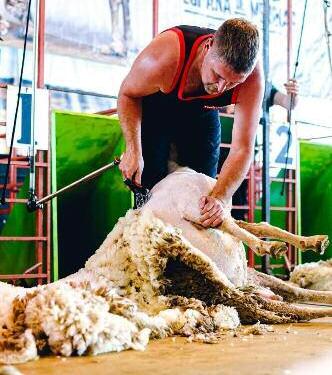

Manuel secured the lowest board score of 2 4, but with the time points under his shearing belt and second lowest board and pen scores, Gavin lifted the silverware and the Spanish Open title The Scot, who was World Champion in 2012 and has won the coveted NZ Golden Shears, has now won Open finals in 12 countries
“The people are so friendly – it was a trip of a lifetime,” said Gavin, who was
hosted by Josep and Jordi from Boletin Esquiladores, the Spanish importers of Heiniger They covered 2000km touring Spain in the week before the event, shearing with a local gang for some practice
Gavin flew back to New Zealand He has recently bought his own farm near Dannevirke in the North Island but still manages a farm and shears when he can
36
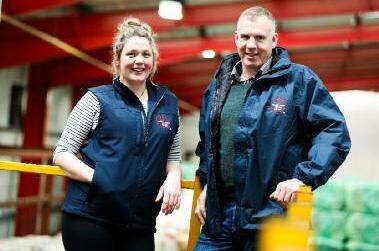

British Wool has launched an ambassador programme, enlisting two representatives per nation across the UK
With a high calibre of ambassadors, the programme follows on from the success UK competitors experienced in the world sheep shearing and wool handling championships at last year ’ s Royal Highland Show
British Wool’s six ambassador roles will be to support the organisation and fibre through good advocacy and best practices, encouraging farmers to be stronger together by supporting British Wool. The ambassadors’ passion for the industry will also hopefully work to motivate the next generation whilst also flying the flag for British Wool in their specific areas
The ambassadors in England will be
New Ambassadors for British Wool
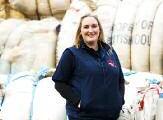
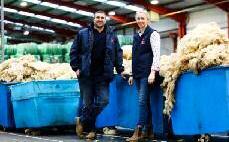
ladies' shearing competitor, training instructor and NSA Regional Chair in the South East, Susie Parish with current world shearing record holder of the nine hour strong wool ewe record 731 ewes, New Zealander Matt Smith
Representing Wales are Gwion Evans, the world shearing champion and Ffion Jones, world wool handling team champion
Flying the flag in Scotland will be current world wool handling champion Rosie Keenan and national shearing team member Hamish Mitchell
Gareth Jones, head of member engagement at British Wool, says: “We are thrilled with the standard and talent of our ambassadors. They are all extremely skilled, passionate, and knowledgeable individuals who can bring a lot to what we do here at British
Wool ”
On top of helping to promote British Wool across its different media platforms, the ambassadors will also gain useful insight into the governance of the organisation and what goes into marketing its members’ wool
Gareth says: “British Wool represents 35 000 sheep farmers in the UK We collect, grade, market and sell wool on behalf of our members to the international wool textile industry for use in flooring, furnishings, and apparel
“As a collective marketing organisation, everything British Wool does is about adding value to our members’ wool and we look forward to working with our ambassadors in promoting this to a much wider audience ”
37

Solway and Tyne Club member Ewan MacTaggart, Castle Douglas, has been named as the winner of the 2024 Texel Sheep Society Spotlight Award.
Announcing Ewan as the winner Society chief executive John Yates said he shone out from a high calibre of finalists due to his in-depth knowledge of the breed and the Society and his overall passion for all things Texel
“Ewan is a fantastic ambassador for the breed and his commitment to Texel is second to none I have no doubt that, in time, Ewan will fulfil all his ambitions within the breed


Acommunity nurse who has been working with Scottish agricultural charity, RSABI, on the delivery of its pioneering Health Hut initiative, has been selected for the prestigious Queen’s Nurse Award.
Irene Scott, who is based at Inverkeithing Medical Group, started working with RSABI at the Royal Highland Show last summer and has played a key role in the delivery of the Health Hut initiative as it has developed over the past year Irene has been working with RSABI to take 100s of farmers’ blood pressures at agricultural events, as well as offering health and wellbeing advice to people of all ages
An auction mart programme is currently being delivered on a pilot basis working in partnership with ANM Group with farmers being offered free “wellbeing MOTs” on busy sale days at
A committed young breeder, Ewan took on management of the Rascarrel flock following the untimely death of his father, Tommy. In the years since then he has had a keen focus on the type of Texel he wants to produce and that he believes the industry requires This has seen the flock flourish in recent years, selling to 9000gns for Rascarrel Fantastic at Lanark in 2022
A committed Club supporter Ewan attends most Club events and has enjoyed success in the Club’s flock competition and has aspirations to be more deeply involved with the Club and the Society in future years
Matt Redman was elected as the new National Association of Agricultural Contractors (NAAC) Chairman, with Chris Gardner as Vice Chairman. They will both spearhead the NAAC, alongside CEO Jill Hewitt, President Meurig Raymond and the NAAC Board.
Matt, of Matt Redman Agriculture is a Cambridgeshire contractor offering whole farm contracts and individual operations Chris relocated his business Gardner Contract Services (formerly Mill Farm Ashorne) to Devon last year, and will continue offering specialist services in the Southwest, including grassland overseeding and vegetation management
Commenting Matt said, ‘I am excited to take my place as Chairman of the NAAC Board and look forward to being
the Thainstone Centre near Inverurie
Dating back to the 1880s, Queen’s Nurses were social reformers who took public health into people’s homes to help families take better care of themselves. Modern Queen’s Nurses are building on this proud heritage –using their pioneering spirit to improve the health and wellbeing of communities in Scotland
A practice nurse from a family farm in Fife, Irene Scott is well aware of the challenges faced by farmers, often living in remote locations with long working hours very often on their own
“To be selected for the Queen’s Nurse Award is real honour My work encompasses all the values outlined in the Queen’s Nurse programme and I am looking forward to being part of the future development of the Health Hut in Scotland,” said Irene

able to assist the office in supporting professional agricultural, forestry, drainage and amenity contractors. Whilst this is a challenging time for the industry, it will be ever more important for professional contractors to take the lead, investing in innovative kit and supporting farmer customers Realistic costings will be vital for longevity and the NAAC intends to lead the industry forward into a new era of farming ’
Chris Gardner added, ‘As contractors take on financial risk, new innovation, groundbreaking technology and data management for customers, the next two years is likely to bring exciting opportunity for professionals in the industry The NAAC will continue to support members so that they can work with farmers to boost productivity, while looking after the environment.’
38
M O V E R S & S H A K E R S
Mr C John Henning OBE NSch FRAgS was elected as the 37th President of the Royal Ulster Agricultural Society (RUAS) John joined the Society as a member in 1979, was elected to Council in 1995 and has served on the Council Show Stewards, Sheep and Show Safety committees He has also held the role of Chairman of the Cattle Committee and was elected twice as Chair of the Winter Fair Committee. Having stewarded at the Balmoral Show and Winter Fair on over 65 occasions, John’s expertise in the ring has proved invaluable to the Society in recent years The 2024 Balmoral Show will not only mark his first engagement as President of the RUAS, but also his 30th consecutive year as an exhibitor Originally from Markethill in County Armagh, he grew up on a dairy farm and from here developed a passion for cattle John alongside his wife and fellow Society member Ann, built their own herd of Aberdeen Angus cattle in Maghaberry which they show regularly

Calum McCall and Robert Harvie have joined the team at Origin Fertilisers covering northern England and south west Scotland Calum has joined Origin as retail technical support covering south west Scotland and will be supported by the team of in-house nutrition agronomists With over 10 years ’ experience at major agricultural merchant Tarff Valley, and a further two years at Carrs Billington, he joins Origin with a strong product knowledge In both roles, he
From 1978 until 2016, John’s name was synonymous with Danske Bank particularly within the agribusiness division and his career and voluntary roles have seen him meet industry leaders and producers from across the province. From his involvement in the Council for Awards of Royal Agricultural Societies (CARAS), to the Ulster Grassland Society, Lantra, northern division of the Guild of Agri Journalists of Ireland and supportive roles within Gleno Valley Young Farmers Club, John has reached the industry at a variety of levels and continues to engage with producers on a regular basis
Speaking about his appointment, John commented “It is a huge honour to be elected President of the Royal Ulster Agricultural Society I attended my first Show almost sixty years ago and have been actively involved with the Society in various roles since 1979 It’s a pleasure to succeed my good friend Mrs Christine Adams as President and I look
became acutely aware of the issues facing modern farmers and the need for sound advice Holding both BASIS and FACTS qualifications, Calum has a clear vision in his new role
“Through my previous jobs, I spent a lot of time talking to farmers and understanding their issues and I believe increasing fertiliser efficiency is a key focus for many in the future There is more interest regarding enhanced fertilisers, rather than applying the same as previous seasons and Origin’s range of prescription nutrition is ideal for this ”
Based in south west Scotland, Calum will be developing his role across the region and helping both livestock and arable farmers achieve more from their fertiliser
In a further strengthening of the team, Robert Harvie joins Origin as an area sales representative covering Lanarkshire and the surrounding areas
Robert hails from a beef and sheep farm in Coalburn, Lanarkshire, so understands the challenges farmers face across the region He joins Origin with experience selling animal health products for a local agricultural supplier.
“I know the region well and have direct experience with the daily

forward to working with all the Council and staff as we celebrate 170 years of the RUAS I cannot wait to welcome everyone to this year ’ s Balmoral Show from Wednesday 15th to Saturday 18th May at the Eikon Exhibition Centre.”
challenges faced on local farms I’ve joined Origin to challenge myself and grow my fertiliser product knowledge, specialising in providing the right fertiliser advice to farmers,” says Robert.
“My aim is to build strong relationships with existing and new customers and work with them and the current Origin team in the area to ensure crop requirements are met ”
Robert and Calum have already started their new roles


The James Hutton Institute’s Deputy Chief Executive and Director of Science Professor Deb Roberts has been appointed to the board of the Scottish Land Commission (SLC)
The Commission’s role is to stimulate fresh thinking and change in how Scotland, as a nation, owns and uses land and to advise the Scottish Government on an ongoing programme of land reform
Professor Roberts trained as an agricultural economist and prior to moving into her current role at the Hutton, her research focussed on understanding how agricultural and environmental policies affect economic development and social wellbeing in rural areas She holds an Honorary Chair at the University of Aberdeen
Scottish agricultural charity RSABI has announced the appointment of Pauline Macmillan as its new Head of Fundraising.
RSABI provides financial, practical, and emotional support to people involved in Scottish agriculture and with its workload steadily increasing, the new role will be vital to help ensure RSABI has the income needed to meet expected demand in the coming years
Pauline joins RSABI after a decade working at Macmillan Cancer Support as Senior Fundraising Manager She brings a wealth of experience gained in the Macmillan role, where she was responsible for a large geographical area
and managed multiple fundraising initiatives, winning an award in recognition of her dedication and determination.
Speaking about her new role, Pauline said she was delighted to have joined the inspirational team at RSABI
“I’m looking forward to playing a part in the great work the charity does to support people in Scottish agriculture This is an important time for fundraising and I’m really enjoying getting to know the Scottish agricultural community and meeting many of the amazing people who are very kindly raising funds to support the work RSABI does,” she said
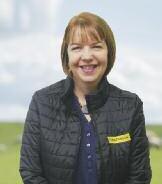
Barenbrug UK has bolstered its agricultural team with the appointment of Donna Mearns as regional sales manager for Scotland.
With 26 years of experience in the agricultural supply industry, Donna brings to Barenbrug a detailed knowledge of Scottish farming, its practices and – most importantly – its people
"At the heart of any good business relationship lies good customer service," enthuses Donna, "and as a 'people person', joining Barenbrug brings me back to a job I love doing, in a very down-to-earth way
"I'm not one to sit behind a desk, so
"It is a huge honour and privilege to be joining the Scottish Land Commission as a commissioner and to have the opportunity to build on the progress made by my predecessors ”
“The importance of land for Scotland’s economy, environment and society has never been clearer and we are at a critical stage in the Land Reform process I look forward to collaborating with colleagues in shaping Scotland's land policies for the benefit of all "
The commission’s current focus will see it continue to advise on opportunities for reforms in how land is owned and used, including the forthcoming land reform bill, as well as providing leadership to shape responsible land ownership in practice

I'm relishing the prospect of getting out in the field and working with Scotland's distributors, merchants and farmers."
Donna is well-known having worked for Carr's Billington, latterly as a regional operations manager. She has also served as secretary for the Scottish Seed Trade Association
"There's a lot of technical knowledge within Barenbrug," Donna notes, "and I will enjoy working with what's a really close-knit team to build the Barenbrug brand here in Scotland "
Barenbrug is one the UK's largest grass-seed breeders, producing UK-bred varieties and UK-grown seed that forms the 'backbone' for grass-seed blends
M O V E R S & S H A K E R S
40
The Royal Association of British Dairy Farmers (RABDF) is delighted to welcome Head of Agrifoods at HSBC, Allan Wilkinson, as their new President, succeeding Lord Ewen Cameron
Allan is a dairy farmer's son from North Yorkshire, who joined Midland Bank in the late 1980s, becoming HSBC's Head of Agriculture in 2010. He has been Head of Agrifoods at HSBC UK for the past eight years, covering food chains and systems He sits on several industry bodies and is a Liveryman of The Worshipful Company of Farmers and a Fellow of the Royal Agricultural Societies
RABDF Chairman Robert Craig said: "We are delighted that Allan has accepted our invitation as President

RSABI, the organisation supporting people in Scottish agriculture, has announced two new appointments to its board of trustees
Carole Brunton and Ian Hope, who have been co-opted to the RSABI board, each bring a wealth of agricultural experience and knowledge to the charity.
Ian Hope, Head of Rural at Galbraith, is an experienced business leader in the agricultural sector who has covered all aspects of rural consultancy and management during his career Ian, who is a partner at Galbraith, also farms in Perthshire and is passionate about making a difference to the farming industry in Scotland He is very enthusiastic about the work of RSABI
Allan's first-hand experience of the challenges of dairy farming, coupled with his banking skills and enthusiasm for the industry, make him ideally qualified to take on this role
"As the dairy industry continues to face challenging and dynamic times, there's no doubt that Allan will have a significant impact and help us to continue making a difference
Allan added: " The RABDF's work in the industry is vast and ambitious Not only are they supporting their members and the wider industry through the various boards and industry bodies they sit on, but their ambitious and highly successful events programme is paramount in helping to promote knowledge sharing and connectivity in the dairy sector ” and is looking forward to joining the RSABI board
Fife farmer Carole Brunton is passionate about agriculture and has 37 years of industry experience under her belt Carole began her career as an Agricultural Department Secretary for Elmwood College before becoming a partner in the family farming business, which she continues to run with her husband, while also fulfilling her role as a Project Co-ordinator with RHET Fife
In 2021 Carole was appointed the role of Honorary President of Fife & Kinross District Young Farmers, furthering her work to help fuel the younger generation's passion for farming
Carole and Ian join RSABI Chair Jimmy McLean, Vice-chair, Jane Mitchell and trustees Lois Newton, Sandy Hay, Stephen Young, Mairi Renwick Mackenzie, Patricia Glennie and Christine Bowie
"We are very fortunate to benefit from a high calibre of trustees with a great balance of skills and experience, who give their time and expertise freely and make a huge contribution to the charity," said Jimmy McLean, Chair of RSABI
"This is a crucial time for RSABI in our mission to support people in Scottish agriculture and I am delighted to welcome our two new co-opted trustees who will play a very important role in furthering our efforts
"Both Carole and Ian are exceptionally experienced and equally

enthusiastic about the good work RSABI do Equipped with the knowledge to support the effective running of the organisation, they each make an excellent addition to the board and are warmly welcomed as trustees "
RSABI is looking forward to further expanding its board in the coming months when the charity will be recruiting two trainee trustees
RSABI offers free practical, financial, and emotional support including counselling services, delivered quickly after receiving the initial enquiry. Its free confidential support service is available 24 hours a day, every day of the year, by calling 0808 1234 555 (calls won't show up on phone bills) or through a confidential webchat service, available on RSABI's website www rsabi org uk

41

New With Krone
by Lucy Baker
Krone UK showcased an extensive range of forage equipment at LAMMA (17-19 January 2024), from its market leading machines, to innovative digital technology, including a new 10-rotor tedder and SmartBale mobile app.
The Swadro TC 1570 four-rotor rake and RX 370 forage wagon also made debut LAMMA appearances
Krone also had numerous mowers, including the BiG M, plus two BiG Pack balers and two BiG X foragers, as well as the recently launched GX wagon, displayed on stand
Agritechnica 2023 Innovation Silver Award-winning blade sharpener–Vendro C 1120
Compact in size, the new Vendro C 1120 10-rotor tedder, complete with OptiTurn rotor technology, offers exceptional operational reliability, maximum output and optimised forage quality
Available with either a drawbar or three-point linkage attachment, the trailed tedder has a high-performing working width of 11.2m and works well even in combination with smaller tractors
The working height can be easily adjusted by either the standard manual adjustment via a hand crank or an optional electro-hydraulic system from the cab
A defined headland position allows operator handling with ease, even across uneven ground


SmartBale App
The new SmartBale mobile app, compatible with Krone’s BaleCollect and award-winning SmartConnect technology, simplifies the process of collecting bales from the field.
GPS tracking provides immediate identification and location of specific bales. This allows swift co-ordination of operations in small harvest windows, from unpredictable weather
The app also provides useful data, including harvest conditions and bale origin, age, dimensions and weight, along with colour coding of moisture content This helps prevent the storage of damp crops and gives proof of quality between seller and buyer
Swadro TC 1570
Bridging the gap between the existing Swadro TC 13 7m and 19m rakes, the newly launched Swadro TC 1570 four-rotor rake was shown in the UK for first time at LAMMA.
This addition to the range offers a 15.7m working width, while maintaining compact transport dimensions The new model boasts the same qualities as the rest of the range, with the V-frame concept taken from the Swadro 2000 providing smooth and stable operation
The ISOBUS operator interface includes an advanced colour display, with 3D graphics, animation and updated machine information, with day and night modes
RX 370
Also coming to the UK for the first time, the RX 370 self-loading forage wagon, with the high-capacity OptiGrass cutting system, which sets new cutting and loading benchmarks for professional forage trailers, available in 33m3, 37m3 or 40m3 capacities.
Grass is collected by the 2.12m EasyFlow pick-up and Krone’s proven SpeedSharp blade grinder sharpens 40 or 54 knife configurations in less than five minutes
Optional integral additive applicators are available and incorporate a 200l tank, pump and four spray nozzles, mounted between the pick-up and rotor
Easily operated via an ISOBUS terminal, the operator can visualise the fill level and control the operating mode between continuous flow or only when the pick-up is lowered
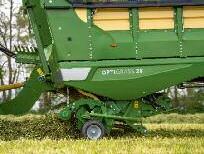
42

Are You Covered?
No doubt everyone has been aware of the above average increasing costs of materials including stone, brick, timber, glass, concrete over the last couple of years
This and the consequential inflationary increase in labour and wage costs as well as shortages of materials has led to large increases in property sums insured as the replacement costs have dramatically shot up This can mean that many properties, from farm buildings, homes, holiday and let premises can be under-insured. The problem on this is that in the event of a claim the insured can be left with a shortfall in payment due to the average clause applying to all such policies In simple terms, if you have only insured for say 75% of the actual rebuild cost you will only receive 75% of the amount of the claim, even if this is well within the overall sum insured, ie a £10 000 claim will be reduced down to £7500
The exception on this is usually on very large sums insured, say on a multi
 by Brett Hannon, Belmont Regency
by Brett Hannon, Belmont Regency
property policy where some insurers will cover it on a first loss basis where a maximum pay out is made up to a figure well below the actual overall re-instatement cost.
Although insurers index-link policies on a recommended percentage it is still necessary for policyholders to check that sums insured are adequate as different types of properties will have differing requirements that need to be taken into account
Brick and Stone built premises may well have increased more in re-instatement costs than those built in modern materials Rebuild costs may change in different regions and properties on off shore islands as well as remote parts of the mainland may well incur additional costs due to a more limited choice of labour and suppliers
This can be a significant factor on the more isolated Scottish islands where special boats may need to be chartered to transport goods.
A number of companies do now offer
surveys to indicate the required cover and many can do desk top valuations to avoid the need for a visit and for the relatively low cost of such it may be a worthwhile investment if it ensures you are fully covered
Values of other items such as livestock, grain, fertiliser, fuel, feed, produce etc have all increased similarly over recent years as have agricultural vehicles and machinery replacement costs, which again will have led to increased insurance premiums
Livestock needs to be insured for the maximum value including expected young stock and likewise produce needs to be covered for it’s maximum replacement costs, usually in late summer /early Autumn when stocks are at their highest
If the use of buildings change such as conversion of barns to farm shops, residential, commercial lets, holiday accommodation etc, it is important that insurers are advised so that the required cover is applied to cover change of use


Latest machinery unveiled at Agritechnica
by Chris McCullough
MACHINERY buffs from all over the world travelled to Agritechnica in November 2023 to see the latest equipment and technology available for farmers and contractors.
It was a welcome return for the world’s biggest farm machinery show, held every two years in Germany, as this was the first Agritechnica held post-Covid The dreaded pandemic forced the cancellation of the 2021 event
A record 470 000 visitors had opportunity to trawl through 24 halls set on 39 hectares, packed to the brim with machinery
In total, 2812 exhibitors from 52 countries supported the show organised by the DLG, German Agricultural Society A number of manufacturers took the opportunity to reveal new machines to the public while others were content to publicise they were still in business
Alternative fuelled tractors and other self-propelled machines are becoming more apparent at these shows, as companies try to show their willingness to help reduce agricultural emissions
Timo Zipf, Agritechnica project manager, said: “As the world's leading trade fair for agricultural machinery, Agritechnica 2023 has demonstrated how highly innovative the industry is “After four years, exhibitors were
finally able to present their wealth of innovations to the world here in Hanover once again Everyone appreciated the opportunity for face-to-face discussions, exchanges and networking opportunities, also to make new business contacts ”
The next Agritechnica will take place from November 9 to 15, 2025
New Holland CR11 Combine
New Holland’s CR11 combine was unveiled at the show promising high productivity and minimal grain loss
Thanks to its 775hp C16 engine, two 24inch rotors, a 20 000 litre capacity grain tank and a 210litres per second unload rate, the CR11 will significantly increases productivity
The new Twin Clean cleaning shoe comes with two cleaning systems behind each other, with two upper sieves, two lower sieves, two clean grain augers and two sets of pressure sensors to measure cleaning shoe load
Also, the completely new residue management system comes with a new chopper and chaff spreader system, designed to ensure the best chop quality and even residue spreading over up to 60ft cutting width
MF 9S Series Tractors
Massey Ferguson launched its 9S tractor series of six models ranging from 285hp to 425hp
This new range replaces the outgoing MF 8700S series All six models are powered by an updated six-cylinder, 8 4-litre AGCO Power engine, with Engine Power Management (EPM) offering up to 30hp extra for all models, except the flagship 9S 425
Models start with the MF 9S 285 at 285hp with a max EPM power of 315hp, while torque output is 1250Nm at 1500rpm at max power and rises to 1400Nm at 1,500rpm with EPM
Updates to the engine include a new turbocharging design with a single advanced turbo replacing the twin turbo system. The 660-litre fuel tank is 10% larger than previous models, while the engine is also designed to run on HVO fuel
The new models are fitted with MF’s renowned Dyna-VT continuously variable transmission that offers new power management to deliver additional power and torque compared with previous models
44

RSABI provides vital support to agricultural industry.
The service RSABI delivers ranges always given with respect, undercall RSABI on Freephone 0808 1234 555 – open 24 hours a day, every day of the year – or use www.rsabi.org.uk.
Freephone 0808 1234 555 Live Webchat 24/7 via www.rsabi.org.uk

To join our Supporters’ Scheme from just £2 a month – and help us deliver our services –please visit www.rsabi.org.uk.
rsabi@rsabi.org.uk
Follow us on Scottish charity no: SCOO9828

Siloking
SiloKing exhibited one of its new electric Truckline eTruck 2012 feed mixers that range from 12m3 to 20m3 capacity.
On the stand was the 18m3 version with a new individual drive concept for mixing augers and wheels, as well as high quality lithium-ion batteries
Except for the smallest model, the eTruck 2012-12 with a capacity of 12m3 and only one mixing auger, the new models each have two mixing augers, each driven by its own motor
The total system power of the mixing drive is 80kW, which helps ensure a homogeneous feed mixture even with round bales
Battery life sufficient for two to four container fills, and allows for 3000 to 5000 full charge cycles
In the cab, the control panel includes functions for mixing at 17rpm, cutting at 40rpm, and residual emptying at 55rpm. The driving speed ranges from 0 to 15km/h.
One of the latest grass windrowers on display from Roc, currently merging into the Kverneland Group, was the RT1150 model with overall working width of 11.5m.
These machines differ from traditional rakes as the Roc RT1150 lifts the crop up before transporting it on a conveyor belt, whereas traditional rakes drag the crop on the ground up into the windrow
By using the Roc system the crop is lifted and put gently on the belt in order to be transported and deposited centrally without any damage
Roc claims its machines save power and fuel consumption as only one 100hp tractor is needed to form a swath every 10m with the RT1150
This machine folds up to 3m wide and 3m tall for road transport and sits on 500/50 x R17 tyres.
10.5m Trailing Shoe
Northern Ireland based SlurryKat displayed its new Farmline 9m and 10 5m trailing shoe The new 9m model weighs 600kgs and the 10.5m model is 636kgs. Both the 9m and the 10.5m models exhibit unique inverted booms in the transport position
The extra width for the new models was achieved by adding a novel flip-over end section on the side arms, which is operated by a hydraulic cylinder
With flip-up shoes on the central and outer sections, this makes it easier for the operator to make headland turns Also, the machine does not need to be folded up to reverse, all the operator has to do is flip up the shoes, carry out the manoeuvre, then drop the shoes and work away
46
eTruck 2012 Roc RT1150 Windrower SlurryKat Farmline






47 MACHINERY RING BENEFITS! Speak to your local Machinery Ring about opportunities when purchasing Case IH tractors, combines and balers. Bruce Farm Machiner y Bogauldy, King Edward, Banff AB45 3LX 01261 821 659 07801595414

JCB 560-80 Telehandler
JCB previewed its new high-power JCB Loadall 560-80 AGRI Pro with six tonne maximum lift, 7 9m maximum lift height, powered by a 129kW (173hp) JCB Dieselmax engine
The flagship model features JCB’s exclusive 40kph JCB DualTech-VT transmission, which combines two transmissions in one; hydrostatic for yard work and a three-speed powershift transmission for on-road and field operations
It has a small footprint and excellent visibility making it agile in smaller workspace areas
Case IH Quadtrac 715
Case IH just had to show off the biggest tractor the manufacturer ever built – its Case IH Quadtrac 715 tractor rated at 715hp
At the heart of this machine is the FPT Cursor 16 engine, which delivers up to 778hp at maximum power Together with increased torque, improved engine power, an 11% larger fuel tank and other improvements, Case IH says this beast will deliver high productivity.
Maximum pump flow rate is 428l/min and it has the 16 speed Powerdrive transmission for ultra smoothness in the field
Only available in tracked Quadtrac format, the new tracks are 305mm longer, giving more ground contact offering enhanced power transfer, greater traction, and reduced compaction.
McHale V6 760 Baler
McHale launched its new V6 760 and V8 960 fully automatic variable chamber balers, which are the highest spec machine in the V6/V8 range
McHale has created its highest output pick-up for the V6760/V8960 to increase crop intake through more efficient crop flow The new tapered feed channel encourages the crop to flow from the pick-up, towards the rotor and into the bale chamber, maximising throughput To reduce maintenance, all Profi-Flo pick-ups are fitted with a heavier driveline which reduces chain load and increases chain life
Customers can choose between a five-tine bar cam track pick-up or, the optional, six-tine bar camless pick-up which has increased in width.
A 540 rpm gearbox is equipped on the V6760/V8960 as standard, plus to optimise machine performance, a 1000 rpm gearbox is available as an optional extra These fully automatic machines are Isobus compatible with the option of using McHale’s Iso-Play 7 or Iso-Play 12 terminals
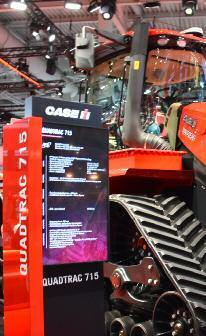

Faresin PF1.14
Electric Wagon
Faresin revealed its first all-electric Leader PF 1 14 self-propelled mixer wagon with 14 cubic metres capacity
The machine is powered by a 91kW, 210Ah lithium iron-phosphate battery integrated with Farmatics telematics for remote control, which is installed in the rear engine compartment
Traction power is provided by a 51kW electric motor positioned in the rear axle, which also transmits motion to the front axle via a cardan shaft. The system has two gears that allow travel up to a maximum speed of 20 km/h.
The Leader PF Full Electric has four drive and steering wheels that allow three types of steering It is also equipped with a hydro-pneumatic suspension that can be adjusted in height via a control in the cab, allowing comfortable and safe driving
A 45kW electric motor supplies power for all types of mixes thanks to the eight mixing speeds In addition, a special cleaning function allows the auger to completely discharge the mixture inside the mixing tub
48



Joskin Bioflex 720 R6F6 Aerator
New on the Joskin stand was one of its new crop weeders, which have three elements for models up to 7 2m working width and five elements for models up to 12m working width
Each element includes up to 96 tines distributed over six consecutive rows
The 7mm diameter tines on the Bioflex are highly flexible, following the ground relief perfectly, while remaining independent of one another
Bioflex aerators are available in 4 8m, 6m and 7 2m versions with single folding system and in 8 4m, 9 6m, 10 8m and 12m versions with double folding system.
As standard, they are equipped with 3+4 gauge wheels for models up to 7 2m, and 5+6 gauge wheels for those up to 12m working width
Each model is hitched to the three-point linkage of the tractor and has an external width of just 2 5m

Pottinger Novacat F3100 Opticurve
Afront mower with automatic curved side shift was introduced on the Pottinger stand Namely the Novacat F3100 Opticurve, this mower guarantees a perfect overlap with the rear mower and ensures the tractor drives along a clear track free of forage when cornering and working on steep ground.
Even if the tractor drifts sideways when cornering or on steep terrain, the rear tyre of the tractor does not run over grass that has not been cut yet because the mower shifts towards the inner radius of the curve
Merlo TFe 43.7
Anew full size electric TFe 43 7 telehandler was on the Merlo stand, still in prototype stage but already creating huge interest It has a modular pack design, which means the electric pack can be moved from one machine to others in the Merlo stable The Italian manufacturer has switched to Lithium-ion batteries for this larger machine giving it more output and productivity It has a lift capacity of 4 3 tonnes up to seven metres high.

49
CLAAS has added two new five-walker combines to its Evion range, equipped with modern Cummins six-cylinder engines and the Cemis 700 control concept
The Evion combines, namely 410 and 430 models, are equipped with a single-drum tangential threshing unit with a large 600mm threshing drum and a synchronised impeller combined with five 4.40m long straw walkers and a feeder housing width of 1420mm.
This results in an impressive threshing concave area of 0.95m2 and a separation area of 6 25m2 provided by the straw walkers The threshing drum speed in the Evion Classic is infinitely adjustable over a range of 480 to 1150rpm using the Cemis 700 terminal

Concave clearance adjustment is performed hydraulically from the cab and features integrated overload protection provided by a diaphragm accumulator to prevent blockages from occurring in the threshing unit
The arrival of the Evion completes the restructuring of the entire Claas combine harvester range, which began with the new Lexion in 2019 As successors to the Avero and the smaller Tucano models, these three five-walker combine harvesters round out the lower end of the range below the Trion.
Evion models are powered by the 6 7-litre Cummins B6 7 engine, which meets the Stage V emission standard The full rated output of 204hp by the Evion 410 and 231hp by the Evion 430 is
available at just 1900rpm, while the idle speed is a low 800rpm
Dynamic Power engine management ensures that the engine only delivers as much power as is actually required at any time, which can reduce fuel consumption by up to 10 percent
The ground drive is provided by a three-speed, manually shifted hydrostatic drive with a choice of top speeds 20, 25 or 30km/h. For the rear axle, customers have a choice of wheels with a diameter of 1.35m or, for maximum soil protection, as much as 1 50m
The sieve pan works with the upper and lower sieves moving in opposite directions and has a total sieve area of 4 80m2
50
In addition to electric sieve adjustment, the standard equipment for all Evion models includes a loss measurement system Adjustment of the speed of the radial fan is performed from the cab and can even be controlled automatically with the optional Auto Slope functionality when harvesting uphill or downhill
An inspection window allows the returns to be viewed conveniently from the operator's seat Available as an option is the 3D cleaning system, which is able to compensate for a lateral tilt of up to 20 percent when harvesting on slopes.
The grain tank integrated behind the cab holds 5600l in the Evion 410 and 6500l in the Evion 430. Sensors alert the
operator when the fill level reaches 70 percent and then 100 percent
In addition to this functionality, a large grain tank inspection window gives the operator a direct, comprehensive view of the fill level and grain quality
When it comes to unloading, all three Evion models benefit from the 330mm diameter of the grain tank unloading auger and the resulting 90-litre per second unloading rate.
The 105-degree pivot angle of the grain tank unloading auger ensures that the operator always has a perfect view of the offloading process
The Evion is available with an optional 72-knife straw chopper as an alternative to the standard 52-knife
version Both shear bar and friction bar can be adjusted without tools while the switchover from chopping to swathing is performed at the right-hand side of the straw discharge hood
The straw guide plates are adjusted manually to the working width so that uniform distribution is ensured even when operating with a cutterbar width of 6 80m
Both new Evion models are equipped as standard with automatic climate control and a camera while footrests on the steering column are available as an option, as is a 30-litre cool box under the instructor's seat Other optional items include an air-suspended comfort seat, electrically adjustable rear-view mirrors and a second camera

Two new Claas Evion combines hit the market
by Chris McCullough
51
More Transmission Options for Case IH Vestrum Tractors
 by Chris McCullough
by Chris McCullough
FARMERS can now choose the ActiveDrive 8 powershift transmission in lieu of the CVXDrive continuously variable transmission (CVT) on Case IH 100hp to 130hp Vestrum tractor range
The ActiveDrive 8 option was previously only available on the 115hp to 150hp Maxxum tractors and now gives Vestrum operators a cheaper alternative if they do not require full capabilities of CVT.
Range one offers a 0-10.7 km/hr speed band to suit heavy draft work, while range two, with a speed bracket of 4 3-18 1 km/hr, meets most work needs
For road travel, the transmission can start in range three, with a 0-40 km/hr speed range, a skip-shift function allowing quick powershift step progression A creep speed option allows speeds down to 190 m/hr for specialist applications
Vestrum ActiveDrive 8 tractors are available with a choice of two specification packages ‘Selection’ models are equipped with mechanical remote valves, an 80 or 110l/min hydraulic pump, three-speed PTO, front linkage options.
There are two roof options: a low roof version of 2.7m features a panoramic
window for loader work, while a standard roof alternative comes with a height of 2 83m
Air conditioning, passenger seat and cab suspension can be chosen The alternative ‘Advanced’ specification features additional equipment including, front linkage with Front Hitch Management, electro-hydraulic remotes, plus optional features such as Advanced Headland Management, auto guidance managed via the AFS Pro 700 Plus display and ISOBUS options.
Whether specified with CVXDrive or ActiveDrive 8, Vestrum tractors use the same FPT NEF 4 5-litre/four-cylinder Stage V engines Developing up to 10hp more than their rated output between 1700rpm and 1900rpm, they produce maximum torque at 1300rpm
The standard implement coupling package includes a Cat II/III N 5,600kg rear hitch, while a 2,300kg front hitch is optional, as is a 1,000rpm front PTO with wet clutch Manoeuvrability is aided by a 4 5m turning circle
With noise level of 69dB(A), the suspended cab options include a loader joystick with transmission control buttons. The AFS Pro 700 Plus touchscreen terminal comes with a quick-start menu and up to four camera
inputs
AEF ISOBUS certification for Universal Terminal and Task Controller functionalities guarantees compatibility with AEF ISOBUS-certified implements Optional AFS Connect telematics capability allows remote monitoring and instant data capture
Additional features including AFS AccuGuide auto guidance and AFS AccuTurn Pro automated headland turning technology are also available.
Christel Diebolt, Case IH product marketing manager for Vestrum tractors, said: “By adding the ActiveDrive 8 eight-step powershift option to the Vestrum line, we are aiming to broaden its appeal by offering a greater range of specification to customers in this power segment, to meet a wider range of needs
“This is a true powershift that uses our double-clutch technology so there is no loss of drive or traction during speed or direction changes It also allows the tractor to move off in the highest range, increase field speed without interrupting power to the wheels, deliver almost imperceptible gear changes and, via the Active Clutch II feature, come to a standstill using only the brake pedal.”
52

Results from the ADAS Nutrition Challenge 2023 have favourably demonstrated the benefits of controlled-release crop nutrition programmes, through both efficiency and yield gains, when compared to RB209 and ADAS expert recommendations
With field sites in Norfolk and Yorkshire, the project objective was to test a range of spring nutrition products and practices to identify if new ways to maximise yield, while minimising input costs, could be found.
The benchmark plots followed RB209 recommended applications of N at a rate of 220kgN/ha in Yorkshire and 160kgN/ha in Norfolk, while the ADAS experts’ application rates were significantly higher at 286kgN/ha in Yorkshire and 222kgN/ha in Norfolk
Timac Agro UK entered the challenge with a nutrition plan comprising a combination of phased-release N and phosphorus (P), using Sulfammo and TOP-PHOS, with the aim of demonstrating that lower doses of N and P do not have to be at the detriment of yield
In the Timac Agro UK trial plots, N
was conservatively applied to winter wheat at a rate of 201kg/ha in Yorkshire and 141kgN/ha in Norfolk
David Newton, technical manager at Timac Agro UK, outlines the yield results
“Our Yorkshire trial achieved a yield of 10 21t/ha, which came in marginally above RB209 at 10 08t/ha but lower than the ADAS experts’ high-N program at 11 16t/ha,” he says
“Similarly in Norfolk, our trial achieved a higher yield than RB209 at 9.75t/ha compared to 9.51t/ha. However, in this scenario, the Timac Agro recommendation considerably outperformed ADAS experts, which came in at 8 41t/a ”
Mr Newton goes on to break down the N uptake and use efficiencies, with trends evident in both locations “In Yorkshire, ADAS YEN have assessed that our trial delivered 0 65 N uptake efficiency, outperforming RB209 at 0 61 and ADAS at 0 59 Similarly in Norfolk, they report that our plot achieved 0 67, whereas RB209 and ADAS came in lower at 0 58 and 0 42 respectively ”
“The YEN team have measured that our Yorkshire scenario achieved a higher
Trial Result Success for Controlled Release
Fertiliser
by Lucy Baker
NUE of 33 75% compared to 30 96% for RB209 and 27 68% for ADAS In Norfolk, the pattern continues for us coming out on top at 35 47% NUE, compared to RB209 at 31 93% and ADAS at 22 68% ”
He explains although yield differences are marginal in some instances, the overall results indicate applying high-quality, controlled-release N at a lower rate allows growers to at least maintain yield, while also reducing their carbon footprint
“These results show the relative efficiency of N is superior when applying high-performing, gradual release fertilisers. For instance, in the Norfolk trial, applying 81kg less N than the ADAS recommendation resulted in a 13% higher yield,” says Mr Newton
“Our controlled-release N and P technologies offer protection against pH related losses, and prevent volatilisation and leaching, all the while improving soil health year-after-year, so subsequent applications can be further reduced ”
To learn more about Timac Agro UK crop and soil health nutrition solutions, visit https://uk timacagro com/
53
CLAAS CMATIC – Performance Driven










Seamless acceleration and deceleration between 0-50kph.









Uninterrupted power for maximum productivity and minimising fuel usage.

SELLARS Oldmeldrum
Tel: 01651 872891 SELLARS Cupar Tel: 01334 658210



3 simple drive modes. Auto stretch brake.


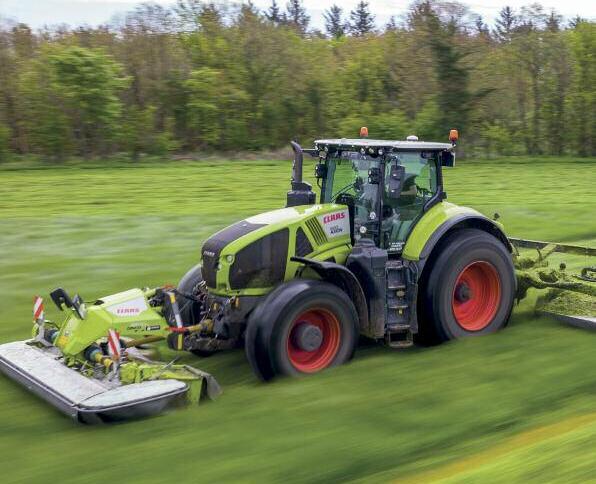

Tractor implement control. Engine droop adjustment.


SELLARS Forres Tel: 01309 676708
CLAAS CMATIC – the fully stepless transmission that’s performance driven, ef ciency driven and with you in the driving seat.
Contact your local SELLARS branch today for a demonstration.
SELLARS Huntly Tel: 01466 792165 SELLARS Letham Tel: 01307 818545 SELLARS Perth Tel: 01738 620549 sellar.co.uk SELLARS Stirling Tel: 07713 067326




You have to read this book several times to truely appreciate the value of its content A small book packed full of wisdom
Throughout history there has been one quality that great leaders, thinkers, personalities shared. Ryan Holiday calls it stillness, the ability to be steady, focused and calm in a constantly busy world
He uses stories of Abraham Lincoln, John F Kennedy, Napoleon, Tiger Woods, Leonardo da Vinci, Winston Churchill and many others and shows us how crucial stillness is, if we want to navigate this world of chaos
This book will inspire you and help

Photographer John Bentley captures the sheepmen of the Yorkshire Dales, Westmorland Fells and the Lake District in the four seasons, in this stunning pictorial publication – Hill Farming in the North of England
The instant popularity of this book surely has something to do with
Helen being the wife of James Rebanks, the Lake District sheep farmer and author of fame
Admittedly it made me want to read this book as well And I am glad I did
A very busy farmer's wife with four children uses some of her precious time to write about her life, her ups and downs and feeling undervalued by society as a woman who choose to stay at home and look after her family. On one hand is this often romanticized 'beautiful' life in the countryside and on the other the inglorious and often unappreciated – because unpaid – life of a housewife/mother/farmer's wife
Helen takes the reader on her personal journey with great honesty and what it took to finally feel confident in her choices The result: 'ordinary' life is of more value than most of us think That caring for ourselves, our loved ones, our communities and the planet, especially by choosing good food from good farming can be the most fulfilling life – if we choose to
A bonus are the many delicious recipes of wholesome food scattered throughout the book and along her journey.
Helen Rebanks: "The Farmer's Wife. My Life in Days," Faber & Faber, London 2024, 384 pages, ISBN: 978-0571370597, £10.99
you to practice stillness You will understand, why stillness is needed for inner peace and is the key to a happy life And not chasing money and accomplishments, or overwhelming ourselves with too much information, because, "we want to stay on top of things."
One of the simplest and most accessible ways into stillness is gratitude Equally important is "to feel enough "
Imagine the stillness that "sense of enough" brings "No ceaseless wanting No insecurity of comparison Feeling satisfied with yourself and your work What a gift!"

Published by Amberley Publishing in 2023 this soft cover, 128 page, landscape orientated book retails at £18 99 It is also available in Kindle, Kobo and iBook formats
It is written simply and gives anyone from a non-farming background an insight to the remarkable life and hard work of the high country farmers who toil come rain, snow or shine in the dramatic landscapes of the North of England It uses the local
John has gone out with the farmers on their daily rounds and got his boots dirty in all weathers portraying the real McCoy of the farming world. He has gone behind the scenes, gathering the
sheep off the hills and turned up for winter feeding and hay making as well as all the social days out at shows, sales and dog trials
It shows how the next generation may be using technology and the internet in their farming businesses, but farming in the hills is still very much steeped in tradition, passed down the generations
Laid out in the four seasons, this book epitomizes the hill farmers’ year
Any sheep farmer would appreciate this title – it is one that you would flick through the photographs again and again and it would sit comfortably on any farmhouse coffee table.
B O O K R E V I E W S
by Petra Jacob

In a secluded valley on the Lofoten Islands in the far north of Norway the Åland family produces cheese for customers from around the world – who travel along the coast on the famous Hurtigruten mail boats
Aalan Gård, the organic goat farm of Tove and Knut Åland in Lauvdalen, a secluded valley of the Lofoten Islands in north western Norway, seems like a place far away from the rest of the world.
And yet: the Ålands are connected to the wide world. "Every year, around 15 000 visitors come to the goat farm, from Japan, the USA and Mexico," says Tove during a tour of the farm and cheese dairy The majority of visitors are ship passengers who travel along the west coast on the legendary Hurtigruten These mail boats call at 34 coastal towns and supply them with
mail, people and goods The boat route from Bergen up to Kirkenes on the Russian border is considered one of the most beautiful in the world and can also be booked by tourists
On board the ship Hurtigruten guests are served dishes made from fresh local ingredients from more than 100 suppliers along the Norwegian coast. Tove and Knut Åland supply
Hurtigruten with around 4 5 tonnes of organic cheese per year
During an excursion booked on board, the goat farm Aalan Gård can be visited as well The participants disembark at the port of Stamsund,
three hours later they are back on the ship, which has meanwhile arrived at the port of Svolvær Both places are also important for the Ålands – when Hurtigruten orders cheese Tove delivers the cheese in person to the ship It is 30 minutes by car to the harbour in Stamsund and 50 minutes to Svolvær She connects the delivery runs with errands and deliveries to other customers such as restaurants and delicatessen shops.
Supplying the renowned Hurtigruten with cheese is a sign of quality Aalan Gård's cheeses have won many awards
The first around 15 years ago
The walls in the adjoining room to the farm shop are decorated with certificates and awards, including bronze at the prestigious World Cheese Awards for "Capra" made from goat's milk The sudden recognition and the amount of interest surprised her, Tove admits "Us, Little farmers from Lauvdalen," they thought at the time
"In 2014, Hurtigruten approached us
56
and asked if we could supply them with cheese," the 62-year-old recalls Hurtigruten had a new concept: the menu served in the on-board restaurant should reflect the region visited on the day They wanted to use seasonal and fresh ingredients supplied by small producers in the respective region; they wanted to support the local producers and at the same time offer the guests on board the opportunity to experience Norway from a culinary point of view Today, Hurtigruten is Aalan Gård's most important customer
Tove and Knut Åland produce around 10 tonnes of cheese on their farm every year. 70 % of it is from their own goat's milk; 30% is cow's milk and is purchased from an organic farmer whose farm is only 15 minutes away.
"We never wanted to make so much cheese," Knut admits There are 200 dairy goats on the farm Even though they are reminiscent of a wide variety of breeds, "we simply call them Norwegian dairy goats," he explains
The farm has 400 dekar of land, which is about 40 hectares, 12 hectares are owned, the rest is leased In summer, hay and silage are produced on these meadows, which are used as winter fodder In addition, a concentrate of oats, proteins and minerals is added in winter
Winters in northern Norway are long and cold and there can be a lot of snow well into April. Summers are short, but intense; Lofoten is located above the Arctic Circle and for about six weeks the sun does not set at all "Then everything grows really well," says Knut Åland "The grass does not grow very high because of the relatively low temperatures, instead it concentrates all its good ingredients The fodder grass is high quality and produces good milk and gives the cheeses a special taste, says the farmer, who is also a trained cheesemaker At the end of May the goats leave their winter quarters and look for food on the green areas and bushy slopes above the farm and –depending on the weather – will do this until the beginning of October The land is state land and no rent is paid for it.
The goats only come back to the farm for milking. There are about 250 litres of milk per milking session and a goat gives between 2 and 4 litres of milk per day Protein and fat content are similar to cow's milk, between 2 and 4 % These are impressive numbers for goat's milk, he says
Knut and Tove were the first to begin with producing cheese in Lauvdalen in
1996. The beginnings were modest. In 1981, Knut's father signed over a small wooden house with 25 goats and 4 hectares of land Before oil was discovered in 1969, Norway was desperately poor On the Lofoten Islands, people lived mainly from fishing, Knut's father was not only a fisherman but also a carpenter After World War II, there was a state subsidy program, Knut says Norway wanted to produce more food and create new jobs
At that time, farming came into the valley of Lauvdalen: Seven small farms, each with a cow, the cows were herded together and put to the mountain slopes Then, in the late 1950s, disaster struck: all the animals fell from the mountain while grazing. From then on they had goats on the farms, they are good on mountainous terrain
In 1984, Knut and Tove Åland invested in a barn with a milking system "For 80 goats, that was a lot at the time," says Knut In 1991 the farm shop was added and in 1996 a cheese dairy He learned to make cheese on a farm near Oslo, in Sweden and Switzerland and is still educating himself today through "study trips "
"With the production of cheese on the farm, he started to get organic certification In 2008, a milking machine with 2x16 spaces and a larger barn with automatic feeding was introduced When they began, there were 41 goat cheese dairies in the Lofoten, today there are only six left. And in the valley of Lauvdalen, Aalan Gård is the only farm left
Keeping old cheese traditons alive has always been important to Knut The first cheese produced on the farm was the "Capra," a traditional grey mould cheese, which was once widespread in the Norwegian countryside This type of mould occurs naturally on every farm and is completely harmless to humans Therefore the cheese tastes slightly different on each farm
Aalan Gård now produces around ten different types of cheese, two of which are made from cow's milk In addition to "Capra," the best seller is the pretty "Himmeltind." The "Heaven and Mountain," as it is translated, is heart-shaped, covered with red cheese wax and is often given as a gift.
Another traditional cheese is the "Geitgomme," which translates as goat gum Goat's milk is boiled down for many hours until it caramelizes and is refined with raisins and anise Knut got the recipe from a 95-year-old neighbor and she in turn received it from her

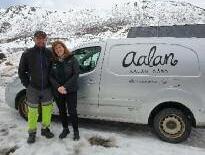


57


parents, as he says: "Who knows how old this recipe actually is." The production of Geitgomme is still purely a craft today, it has never been industrialized.
This is not the case with Brunost, the brown cheese – an unusual but very popular cheese in Norway Strictly speaking, Brunost is not a cheese at all, because it is made from the whey that is a by-product of cheese production To make Brunost, the whey must first be boiled down while stirring vigorously
In the process, the lactose contained caramelizes The longer the whey cooks, the more intense the caramel-like flavor will be and the darker the brown cheese
In Norway, the Brunost is so popular that it is now industrially produced, around 12 000 tonnes per year, mainly from cow's milk. It is also often given as a gift on special occasions, for which it is pressed into old wooden moulds and beautifully patterned cheese blocks are created They have gone one step further, they produce a "Brun Geitost," a brown cheese made entirely from goat whey
Today, Knut is more likely to be found in the barn or milking the goats, less in the cheese dairy, where his

son-in-law Gøran Rasmussen-Åland (40) has been at his side for 14 years now. His wife Tove takes care of sales, PR and the website. "I like people," she says. With her warm and balanced manner, she leads visitors across the courtyard, past the show dairy
Through a large window you can watch Gøran making cheese "Every day it's a different cheese," says Tove A few steps further on is a peephole window to look at the cheese in the maturing cellar The herb garden – for teas sold in the farm shop and served on the Hurtigruten –and the goat barn are also open to visitors
For many, it is a special experience when they are allowed to hold small kids in their hands, reports Tove From the very beginning, one of Tove and Knut Åland's main concerns has been to make agriculture accessible to people who do not come from a farm. From a very early age, they began to offer farm holidays for foster children "I don't remember how many we had," Tove admits Two of them have children of their own – she is a mother of five herself She has seen how good it is for children to work in agriculture and when they get the feeling that they are
needed and do valuable work
As a farmer, you should be open to people, Knut and Tove agree "Making agriculture accessable, that's so important these days, it has become so out of reach – people who don't come from agriculture often have a hard time getting in " That's why it's so important to them to share their work with everyone who is interested, starting with the children "We take any school class that wants to visit," says Tove "Growing up without a connection to agriculture would not be good for society." But she also welcomes visitors from the Hurtigruten excursions. "These people who come to us have tried our cheeses on board and want to know where and how we live and have lots of questions "
In recent years, Tove and Knut Åland have noticed a trend, more and more people are interested in the stories behind food "And that's why it is so important to communicate these stories "
Visiting the farm: Aalan Gård Tove and Knut Åland Lauvdalen 186 8360
Bøstad Internet: www aalan no
Travelling by Norwegian mail boat: www hurtigruten de
58

BOOK – 200 Farmers of Scotland – £25 including postage
Every farmer has a story to tell This book covers the diverse range of Scottish farmers and crofters from those farming the rugged hills of the Highlands to the sandy loams of the Lowlands. From owner occupiers, tenant farmers, share farmers, crofters, farm managers, starter farmers, to new entrants, farming from 10 acres to 31 000 acres – the people are as diverse as the landscapes and environment in which they work
Scotland covers 7.8 million hectares, of that 5.7 million or 73% is farmland, or 79% if common grazing is included.
This book has photographs of 200 farmers and interviews with 109 from across the country from Orkney to Berwick and Durness to Stranraer within its 288 pages It is available from individual bookshops and farm outlets or direct from the author To order direct: drop an e-mail to Eilidh MacPherson at editor@farmingscotland com or private message on facebook – farmingscotland com for details
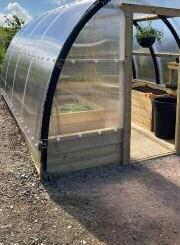



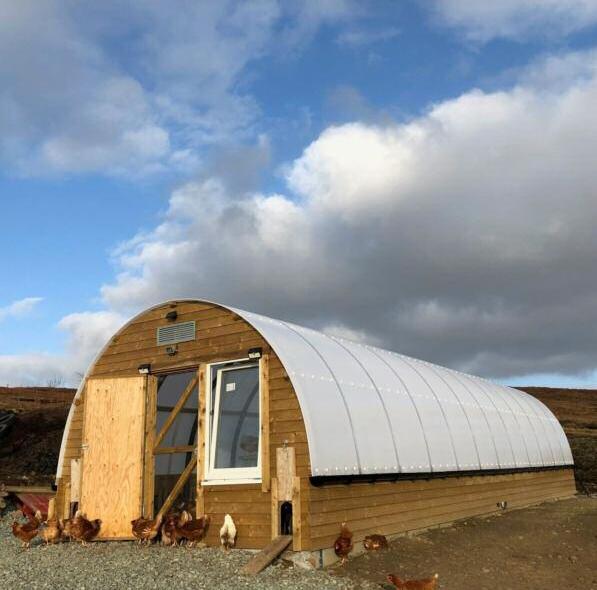
For more info contact Maree on 01806 335577 or info@polycrub.co.uk









 by Chris McCullough
by Chris McCullough
























 by Eilidh MacPherson
by Eilidh MacPherson

























 by Harry Fisher SAC Consulting
by Harry Fisher SAC Consulting



























































 by Brett Hannon, Belmont Regency
by Brett Hannon, Belmont Regency





















 by Chris McCullough
by Chris McCullough



































